2024
|
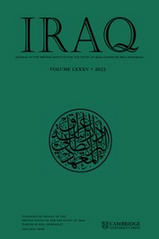 | Amelirad, Sheler; Razmpoush, Abbas; Khanmohamadi, Behroz: Kani Charmou, an Iron Age II graveyard. In: Iraq, vol. 85, pp. 49-71, 2024. @article{nokey,
title = {Kani Charmou, an Iron Age II graveyard},
author = {Sheler Amelirad and Abbas Razmpoush and Behroz Khanmohamadi},
doi = {https://doi.org/10.1017/irq.2023.5 },
year = {2024},
date = {2024-01-11},
journal = {Iraq},
volume = {85},
pages = {49-71},
abstract = {Examining the archaeological findings within the Mannaean kingdom, a significant association with Assyria emerges, highlighting these regions’ interconnectedness. The influence of both Urartian and Assyrian cultures on the Mannaean people becomes evident, indicating a shared cultural heritage or intimate exchanges among these cultures. Notably, the Kani Charmou graveyard in Mannaea serves as a compelling example, revealing a rich assortment of artifacts that parallel those discovered in Ziwiye, a renowned archaeological site in the region. These diverse grave goods unequivocally demonstrate the existence of a robust trade and exchange network between Mannaea and its neighbouring western counterpart, Assyria, and the profound impact of Assyrian culture on Mannaean society. This connection is also evident in religious practices, which show similarities. Through stylistic analysis and the identification of parallels in metal vessels, glazed jars, and a cylinder seal, the proposed dating of the Kani Charmou graveyard aligns with the Iron Age II period.},
keywords = {Iron, Iron Age, Kurdistan, Zagros, Zagros Highlands},
pubstate = {published},
tppubtype = {article}
}
Examining the archaeological findings within the Mannaean kingdom, a significant association with Assyria emerges, highlighting these regions’ interconnectedness. The influence of both Urartian and Assyrian cultures on the Mannaean people becomes evident, indicating a shared cultural heritage or intimate exchanges among these cultures. Notably, the Kani Charmou graveyard in Mannaea serves as a compelling example, revealing a rich assortment of artifacts that parallel those discovered in Ziwiye, a renowned archaeological site in the region. These diverse grave goods unequivocally demonstrate the existence of a robust trade and exchange network between Mannaea and its neighbouring western counterpart, Assyria, and the profound impact of Assyrian culture on Mannaean society. This connection is also evident in religious practices, which show similarities. Through stylistic analysis and the identification of parallels in metal vessels, glazed jars, and a cylinder seal, the proposed dating of the Kani Charmou graveyard aligns with the Iron Age II period. |
 | Busch, Robert; Bernbeck, Reinhard; Hessari, Morteza; Kirsten, Fabian; Lüthgens, Christopher; Pollock, Susan; Rol, Nolwen; Schütt, Brigitta: Linking archaeology and paleoenvironment: Mid‐Holocene occupational sequences in the Varamin Plain (Iran). In: Geoarchaeology, 2024. @article{nokey,
title = {Linking archaeology and paleoenvironment: Mid‐Holocene occupational sequences in the Varamin Plain (Iran)},
author = {Robert Busch and Reinhard Bernbeck and Morteza Hessari and Fabian Kirsten and Christopher Lüthgens and Susan Pollock and Nolwen Rol and Brigitta Schütt},
doi = {https://doi.org/10.1002/gea.21995},
year = {2024},
date = {2024-01-01},
journal = {Geoarchaeology},
publisher = {John Wiley and Sons},
abstract = {Early human habitation of the arid to semiarid Central Iranian Plateau was strongly connected to the availability of water and associated natural hazards, such as flooding and drought events. In this geoarchaeological study, we focus on the occupation at the prehistoric site of Ajor Pazi within the formerly active fluvial environment of the Varamin Plain. Through radiocarbon and luminescence-dated sediment cross-sections, we apply multivariate statistics to sedimentological characteristics of bulk samples collected during a rescue excavation in 2018. Based on facies interpretations, we differentiate depositional processes and present their implications for the environs of Ajor Pazi. Our results show evidence of settlement activities between 6.4 and 5.6 ka cal B.P. (4.4–3.6 ka cal. B.C.E.). Phases of reduced geomorphodynamics can be distinguished when soil-forming processes take place. Our findings provide insights into the hitherto scarcely explored Transitional Chalcolithic II period during which the site of Ajor Pazi emerged and began to shape its environs.
},
keywords = {Holocene, Paleoenvironment},
pubstate = {published},
tppubtype = {article}
}
Early human habitation of the arid to semiarid Central Iranian Plateau was strongly connected to the availability of water and associated natural hazards, such as flooding and drought events. In this geoarchaeological study, we focus on the occupation at the prehistoric site of Ajor Pazi within the formerly active fluvial environment of the Varamin Plain. Through radiocarbon and luminescence-dated sediment cross-sections, we apply multivariate statistics to sedimentological characteristics of bulk samples collected during a rescue excavation in 2018. Based on facies interpretations, we differentiate depositional processes and present their implications for the environs of Ajor Pazi. Our results show evidence of settlement activities between 6.4 and 5.6 ka cal B.P. (4.4–3.6 ka cal. B.C.E.). Phases of reduced geomorphodynamics can be distinguished when soil-forming processes take place. Our findings provide insights into the hitherto scarcely explored Transitional Chalcolithic II period during which the site of Ajor Pazi emerged and began to shape its environs.
|
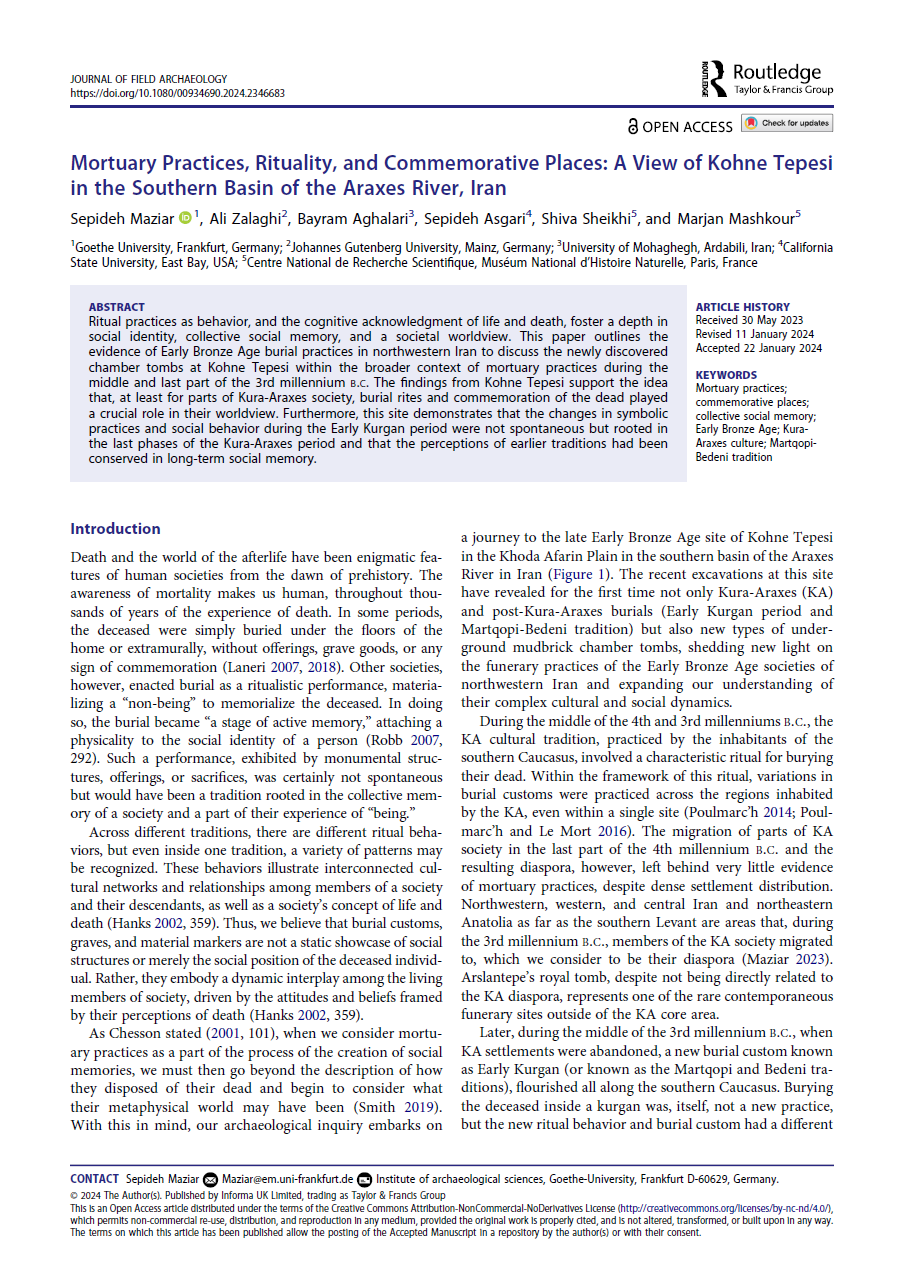 | Maziar, Sepideh; Zalaghi, Ali; Aghalari, Bayram; Asgari, Sepideh; Sheikhi, Shiva; Mashkour, Marjan: Mortuary Practices, Rituality, and Commemorative Places: A View of Kohne Tepesi in the Southern Basin of the Araxes River, Iran. In: Journal of Field Archaeology, 2024. @article{nokey,
title = {Mortuary Practices, Rituality, and Commemorative Places: A View of Kohne Tepesi in the Southern Basin of the Araxes River, Iran},
author = {Sepideh Maziar and Ali Zalaghi and Bayram Aghalari and Sepideh Asgari and Shiva Sheikhi and Marjan Mashkour},
doi = {https://doi.org/10.1080/00934690.2024.2346683},
year = {2024},
date = {2024-01-01},
journal = {Journal of Field Archaeology},
publisher = {Taylor and Francis},
abstract = {Ritual practices as behavior, and the cognitive acknowledgment of life and death, foster a depth in social identity, collective social memory, and a societal worldview. This paper outlines the evidence of Early Bronze Age burial practices in northwestern Iran to discuss the newly discovered chamber tombs at Kohne Tepesi within the broader context of mortuary practices during the middle and last part of the 3rd millennium b.c. The findings from Kohne Tepesi support the idea that, at least for parts of Kura-Araxes society, burial rites and commemoration of the dead played a crucial role in their worldview. Furthermore, this site demonstrates that the changes in symbolic practices and social behavior during the Early Kurgan period were not spontaneous but rooted in the last phases of the Kura-Araxes period and that the perceptions of earlier traditions had been conserved in long-term social memory.},
keywords = {Bronze Age, Kura-Araxes, Social},
pubstate = {published},
tppubtype = {article}
}
Ritual practices as behavior, and the cognitive acknowledgment of life and death, foster a depth in social identity, collective social memory, and a societal worldview. This paper outlines the evidence of Early Bronze Age burial practices in northwestern Iran to discuss the newly discovered chamber tombs at Kohne Tepesi within the broader context of mortuary practices during the middle and last part of the 3rd millennium b.c. The findings from Kohne Tepesi support the idea that, at least for parts of Kura-Araxes society, burial rites and commemoration of the dead played a crucial role in their worldview. Furthermore, this site demonstrates that the changes in symbolic practices and social behavior during the Early Kurgan period were not spontaneous but rooted in the last phases of the Kura-Araxes period and that the perceptions of earlier traditions had been conserved in long-term social memory. |
 | Pollock, Susan; Bernbeck, Reinhard; Rol, Nolwen; D'Anna, M. Bianca; Gharib, Hussein Hama; Abai, Clara; Eger, Jana; Schönberg, J. Lennard; Tolay, Malinda; Wolff-Heger, Lisa: Gird-i Begum – Report on the 2022 Excavations. In: Iraq. FirstView, pp. 1-37, 2024. @article{nokey,
title = {Gird-i Begum – Report on the 2022 Excavations},
author = {Susan Pollock and Reinhard Bernbeck and Nolwen Rol and M. Bianca D'Anna and Hussein Hama Gharib and Clara Abai and Jana Eger and J. Lennard Schönberg and Malinda Tolay and Lisa Wolff-Heger},
doi = {https://doi.org/10.1017/irq.2024.15},
year = {2024},
date = {2024-01-01},
urldate = {2024-01-01},
journal = {Iraq. FirstView},
pages = {1-37},
abstract = {In the summer of 2022, renewed excavations were conducted at the site of Gird-i Begum in the Shahrizor Plain, Kurdistan Region of Iraq. The project aims to examine patterns of mobility, exchange, and resource acquisition practiced by the inhabitants of Gird-i Begum over time. To do so we re-examine the stratigraphic sequence, with a focus on continuities and breaks in site occupation. While the earliest occupation of the site dates to the Halaf period, with limited occupation traces attested during the Ubaid period, the settlement appears to have reached its largest extent during the Late Chalcolithic, which was one of the main foci of this year’s investigations. Our excavations confirmed the presence of Late Chalcolithic levels on the Upper Mound, with an analysis of the pottery as well as 14C dates indicating a chronological span from LC 3 to early LC 4. Work on the Lower Mound brought to light a substantial and previously undocumented Early Bronze Age occupation phase in the early third millennium B.C.E. The massive presence of snails characterizing layers of both periods additionally raised intriguing questions about subsistence strategies and potential crisis at the site.},
keywords = {},
pubstate = {published},
tppubtype = {article}
}
In the summer of 2022, renewed excavations were conducted at the site of Gird-i Begum in the Shahrizor Plain, Kurdistan Region of Iraq. The project aims to examine patterns of mobility, exchange, and resource acquisition practiced by the inhabitants of Gird-i Begum over time. To do so we re-examine the stratigraphic sequence, with a focus on continuities and breaks in site occupation. While the earliest occupation of the site dates to the Halaf period, with limited occupation traces attested during the Ubaid period, the settlement appears to have reached its largest extent during the Late Chalcolithic, which was one of the main foci of this year’s investigations. Our excavations confirmed the presence of Late Chalcolithic levels on the Upper Mound, with an analysis of the pottery as well as 14C dates indicating a chronological span from LC 3 to early LC 4. Work on the Lower Mound brought to light a substantial and previously undocumented Early Bronze Age occupation phase in the early third millennium B.C.E. The massive presence of snails characterizing layers of both periods additionally raised intriguing questions about subsistence strategies and potential crisis at the site. |
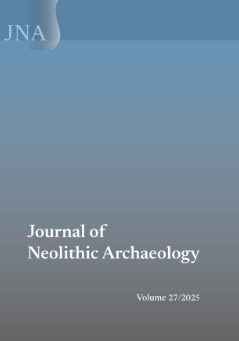 | Hessari, Morteza; Bernbeck, Reinhard; Rol, Nolwen; Pollock, Susan; Wolff-Heger, Lisa: Tappeh Moeinabad. A Late Neolithic Site in the Varamin Plain, Iran. In: Journal of Neolithic Archaeology, vol. 26, pp. 1-29, 2024. @article{nokey,
title = {Tappeh Moeinabad. A Late Neolithic Site in the Varamin Plain, Iran},
author = {Morteza Hessari and Reinhard Bernbeck and Nolwen Rol and Susan Pollock and Lisa Wolff-Heger},
doi = {doi: 10.12766/jna.2024.1},
year = {2024},
date = {2024-01-01},
journal = {Journal of Neolithic Archaeology},
volume = {26},
pages = {1-29},
abstract = {Tappeh Moeinabad is a high mound located in the middle of the Varamin Plain. In 2006, a systematic survey was conducted by the first author and team, followed in 2010 and 2014 by soundings and in 2018 by the investigation of a profile near these soundings. This report summarizes the results of these seasons of archaeological work, describes the remains of architecture identified, and assigns dates to the systematic survey grid. We also investigate the chronology of the soundings with reference to their pottery as well as on the basis of 14C dates. We document a very long prehistoric occupation sequence, paralleling periods Sialk I to II at Tappeh Sialk. According to our analysis, connections between Moeinabad and Tappeh Sialk were particularly close during the Sialk I,3 phase.},
keywords = {},
pubstate = {published},
tppubtype = {article}
}
Tappeh Moeinabad is a high mound located in the middle of the Varamin Plain. In 2006, a systematic survey was conducted by the first author and team, followed in 2010 and 2014 by soundings and in 2018 by the investigation of a profile near these soundings. This report summarizes the results of these seasons of archaeological work, describes the remains of architecture identified, and assigns dates to the systematic survey grid. We also investigate the chronology of the soundings with reference to their pottery as well as on the basis of 14C dates. We document a very long prehistoric occupation sequence, paralleling periods Sialk I to II at Tappeh Sialk. According to our analysis, connections between Moeinabad and Tappeh Sialk were particularly close during the Sialk I,3 phase. |
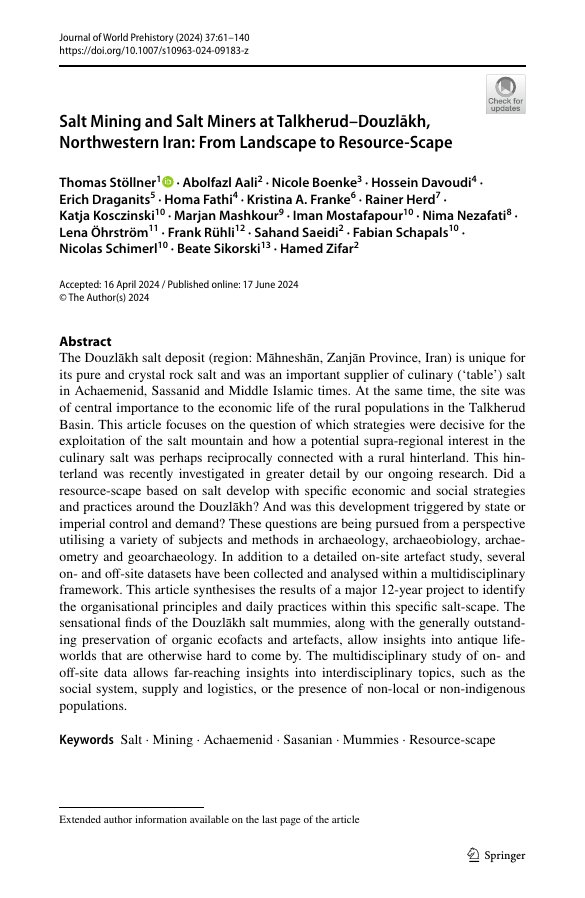 | Stöllner, Thomas; Aali, Abolfazl; Boenke, Nicole; Davoudi, Hossein; Draganits, Erich; Fathi, Homa; Franke, Kristina A.; Herd, Rainer; Kosczinski, Katja; Mashkour, Marjan; Mostafapour, Iman; Nezafati, Nima; Öhrström, Lena Maria; Rühli, Frank; Saeidi, Sahand; Schapals, Fabian; Schimerl, Nicolas; Sikorski, Beate; Zifar, Hamed: Salt Mining and Salt Miners at Talkherud–Douzlākh, Northwestern Iran: From Landscape to Resource‑Scape. In: Journal of World Prehistory, vol. 37, pp. 61-140, 2024. @article{nokey,
title = {Salt Mining and Salt Miners at Talkherud–Douzlākh, Northwestern Iran: From Landscape to Resource‑Scape},
author = {Thomas Stöllner and Abolfazl Aali and Nicole Boenke and Hossein Davoudi and Erich Draganits and Homa Fathi and Kristina A. Franke and Rainer Herd and Katja Kosczinski and Marjan Mashkour and Iman Mostafapour and Nima Nezafati and Lena Maria Öhrström and Frank Rühli and Sahand Saeidi and Fabian Schapals and Nicolas Schimerl and Beate Sikorski and Hamed Zifar},
url = {https://iranhighlands.com/wp-content/uploads/2025/06/s10963-024-09183-z.pdf},
doi = {https://doi.org/10.1007/s10963-024-09183-z},
year = {2024},
date = {2024-01-01},
urldate = {2024-01-01},
journal = {Journal of World Prehistory},
volume = {37},
pages = {61-140},
abstract = {The Douzlākh salt deposit (region: Māhneshān, Zanjān Province, Iran) is unique for its pure and crystal rock salt and was an important supplier of culinary (‘table’) salt in Achaemenid, Sassanid and Middle Islamic times. At the same time, the site was of central importance to the economic life of the rural populations in the Talkherud Basin. This article focuses on the question of which strategies were decisive for the exploitation of the salt mountain and how a potential supra-regional interest in the culinary salt was perhaps reciprocally connected with a rural hinterland. This hinterland was recently investigated in greater detail by our ongoing research. Did aresource-scape based on salt develop with specific economic and social strategies and practices around the Douzlākh? And was this development triggered by state or imperial control and demand? These questions are being pursued from a perspective utilising a variety of subjects and methods in archaeology, archaeobiology, archaeometry and geoarchaeology. In addition to a detailed on-site artefact study, several on- and off-site datasets have been collected and analysed within a multidisciplinary framework. This article synthesises the results of a major 12-year project to identify the organisational principles and daily practices within this specific salt-scape. The sensational finds of the Douzlākh salt mummies, along with the generally outstanding preservation of organic ecofacts and artefacts, allow insights into antique life-worlds that are otherwise hard to come by. The multidisciplinary study of on- and off-site data allows far-reaching insights into interdisciplinary topics, such as the social system, supply and logistics, or the presence of non-local or non-indigenous populations.},
keywords = {Achaemenid, Mining, Resources, Salt, Sasanian},
pubstate = {published},
tppubtype = {article}
}
The Douzlākh salt deposit (region: Māhneshān, Zanjān Province, Iran) is unique for its pure and crystal rock salt and was an important supplier of culinary (‘table’) salt in Achaemenid, Sassanid and Middle Islamic times. At the same time, the site was of central importance to the economic life of the rural populations in the Talkherud Basin. This article focuses on the question of which strategies were decisive for the exploitation of the salt mountain and how a potential supra-regional interest in the culinary salt was perhaps reciprocally connected with a rural hinterland. This hinterland was recently investigated in greater detail by our ongoing research. Did aresource-scape based on salt develop with specific economic and social strategies and practices around the Douzlākh? And was this development triggered by state or imperial control and demand? These questions are being pursued from a perspective utilising a variety of subjects and methods in archaeology, archaeobiology, archaeometry and geoarchaeology. In addition to a detailed on-site artefact study, several on- and off-site datasets have been collected and analysed within a multidisciplinary framework. This article synthesises the results of a major 12-year project to identify the organisational principles and daily practices within this specific salt-scape. The sensational finds of the Douzlākh salt mummies, along with the generally outstanding preservation of organic ecofacts and artefacts, allow insights into antique life-worlds that are otherwise hard to come by. The multidisciplinary study of on- and off-site data allows far-reaching insights into interdisciplinary topics, such as the social system, supply and logistics, or the presence of non-local or non-indigenous populations. |
| Kashani, Natascha Bagherpour; Bönke, Nicole; Herd, R.: The Resource Water, Climate Change And Resilience at Douzlākh, Workshop-Publication “ResourceScapes in the Iranian Highlands – Water, Wind and Minerals as Factors of Appropriation and Integration”. September 12-13th 2022. Session: Fundamentals of a specific environment: climate, vegetation, soils and landuse potentials. In: Forthcoming. @inproceedings{nokey,
title = {The Resource Water, Climate Change And Resilience at Douzlākh, Workshop-Publication “ResourceScapes in the Iranian Highlands – Water, Wind and Minerals as Factors of Appropriation and Integration”. September 12-13th 2022. Session: Fundamentals of a specific environment: climate, vegetation, soils and landuse potentials},
author = {Natascha Bagherpour Kashani and Nicole Bönke and R. Herd},
year = {2024},
date = {2024-00-00},
keywords = {Resilience, Water},
pubstate = {forthcoming},
tppubtype = {inproceedings}
}
|
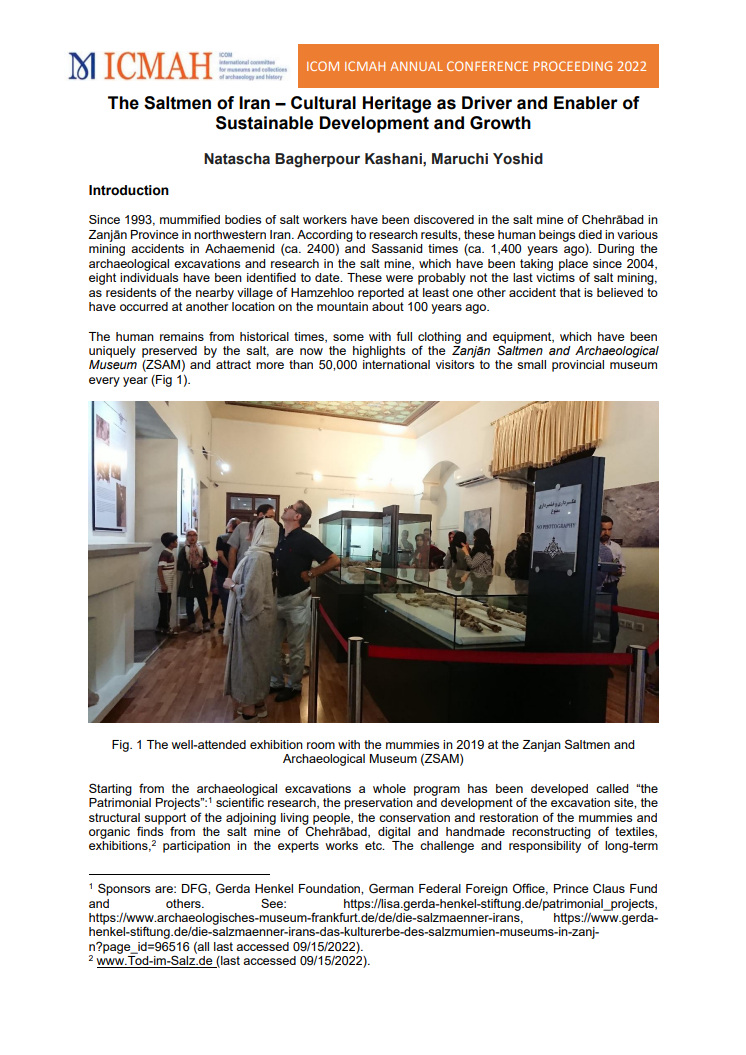 | The Saltmen of Iran – Cultural Heritage as Driver and Enabler of Sustainable Development and Growth. In: Forthcoming. @inproceedings{nokey,
title = {The Saltmen of Iran – Cultural Heritage as Driver and Enabler of Sustainable Development and Growth},
url = {https://icmah.mini.icom.museum/wp-content/uploads/sites/56/2023/05/Papers-Part-1-updated-1.pdf},
year = {2024},
date = {2024-00-00},
series = {International Committee for Museums and Collections of Archaeology and History, ICOM Prague 2022 „The Power of Museum“ },
keywords = {Salt},
pubstate = {forthcoming},
tppubtype = {inproceedings}
}
|
2023
|
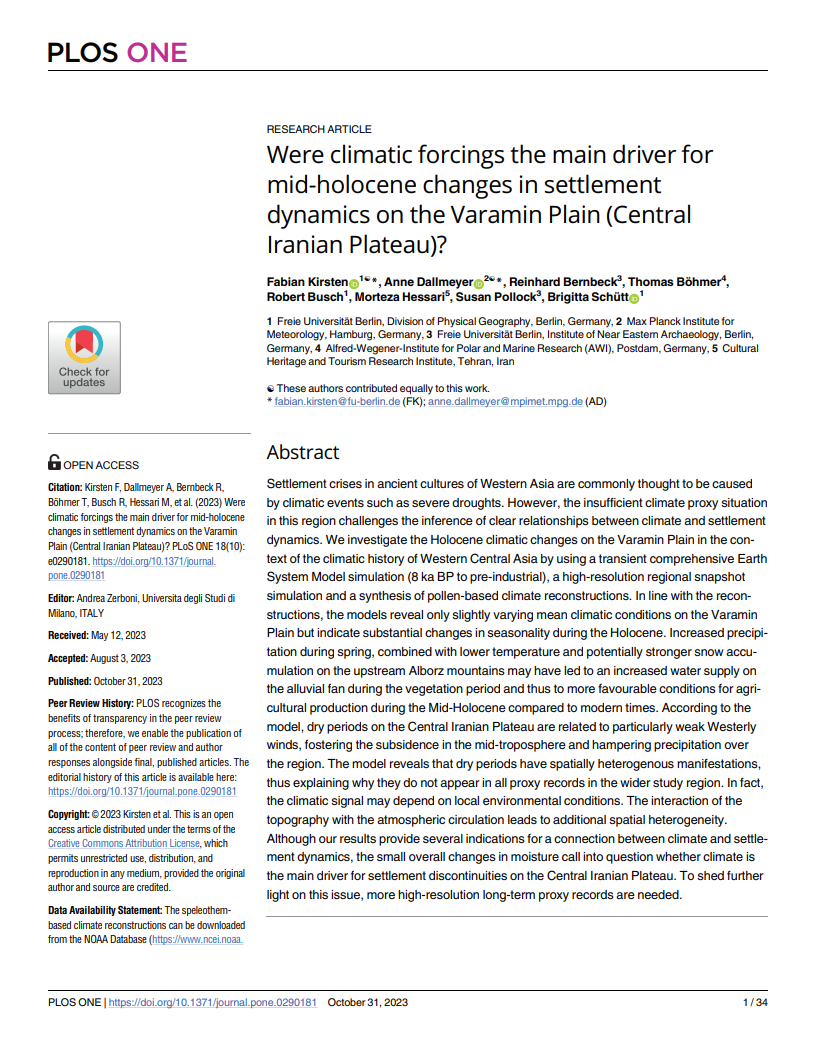 | Kirsten, Fabian; Dallmeyer, Anne; Bernbeck, Reinhard; Böhmer, Thomas; Busch, Robert; Hessari, Morteza; Pollock, Susan; Schütt, Brigitta: Were Climatic Forcings the Main Driver for Mid-Holocene Changes in Settlement Dynamics on the Varamin Plain (Central Iranian Plateau)?. In: PLOS ONE, vol. 18, iss. 10, 2023. @article{nokey,
title = {Were Climatic Forcings the Main Driver for Mid-Holocene Changes in Settlement Dynamics on the Varamin Plain (Central Iranian Plateau)?},
author = {Fabian Kirsten and Anne Dallmeyer and Reinhard Bernbeck and Thomas Böhmer and Robert Busch and Morteza Hessari and Susan Pollock and Brigitta Schütt},
doi = {https://doi.org/10.1371/journal.pone.0290181},
year = {2023},
date = {2023-10-31},
urldate = {2023-10-31},
journal = {PLOS ONE},
volume = {18},
issue = {10},
publisher = {Public Library of Science},
abstract = {Settlement crises in ancient cultures of Western Asia are commonly thought to be caused by climatic events such as severe droughts. However, the insufficient climate proxy situation in this region challenges the inference of clear relationships between climate and settlement dynamics. We investigate the Holocene climatic changes on the Varamin Plain in the context of the climatic history of Western Central Asia by using a transient comprehensive Earth System Model simulation (8 ka BP to pre-industrial), a high-resolution regional snapshot simulation and a synthesis of pollen-based climate reconstructions. In line with the reconstructions, the models reveal only slightly varying mean climatic conditions on the Varamin Plain but indicate substantial changes in seasonality during the Holocene. Increased precipitation during spring, combined with lower temperature and potentially stronger snow accumulation on the upstream Alborz mountains may have led to an increased water supply on the alluvial fan during the vegetation period and thus to more favourable conditions for agricultural production during the Mid-Holocene compared to modern times. According to the model, dry periods on the Central Iranian Plateau are related to particularly weak Westerly winds, fostering the subsidence in the mid-troposphere and hampering precipitation over the region. The model reveals that dry periods have spatially heterogenous manifestations, thus explaining why they do not appear in all proxy records in the wider study region. In fact, the climatic signal may depend on local environmental conditions. The interaction of the topography with the atmospheric circulation leads to additional spatial heterogeneity. Although our results provide several indications for a connection between climate and settlement dynamics, the small overall changes in moisture call into question whether climate is the main driver for settlement discontinuities on the Central Iranian Plateau. To shed further light on this issue, more high-resolution long-term proxy records are needed.
},
keywords = {Climate, Holocene, Settlement mobility},
pubstate = {published},
tppubtype = {article}
}
Settlement crises in ancient cultures of Western Asia are commonly thought to be caused by climatic events such as severe droughts. However, the insufficient climate proxy situation in this region challenges the inference of clear relationships between climate and settlement dynamics. We investigate the Holocene climatic changes on the Varamin Plain in the context of the climatic history of Western Central Asia by using a transient comprehensive Earth System Model simulation (8 ka BP to pre-industrial), a high-resolution regional snapshot simulation and a synthesis of pollen-based climate reconstructions. In line with the reconstructions, the models reveal only slightly varying mean climatic conditions on the Varamin Plain but indicate substantial changes in seasonality during the Holocene. Increased precipitation during spring, combined with lower temperature and potentially stronger snow accumulation on the upstream Alborz mountains may have led to an increased water supply on the alluvial fan during the vegetation period and thus to more favourable conditions for agricultural production during the Mid-Holocene compared to modern times. According to the model, dry periods on the Central Iranian Plateau are related to particularly weak Westerly winds, fostering the subsidence in the mid-troposphere and hampering precipitation over the region. The model reveals that dry periods have spatially heterogenous manifestations, thus explaining why they do not appear in all proxy records in the wider study region. In fact, the climatic signal may depend on local environmental conditions. The interaction of the topography with the atmospheric circulation leads to additional spatial heterogeneity. Although our results provide several indications for a connection between climate and settlement dynamics, the small overall changes in moisture call into question whether climate is the main driver for settlement discontinuities on the Central Iranian Plateau. To shed further light on this issue, more high-resolution long-term proxy records are needed.
|
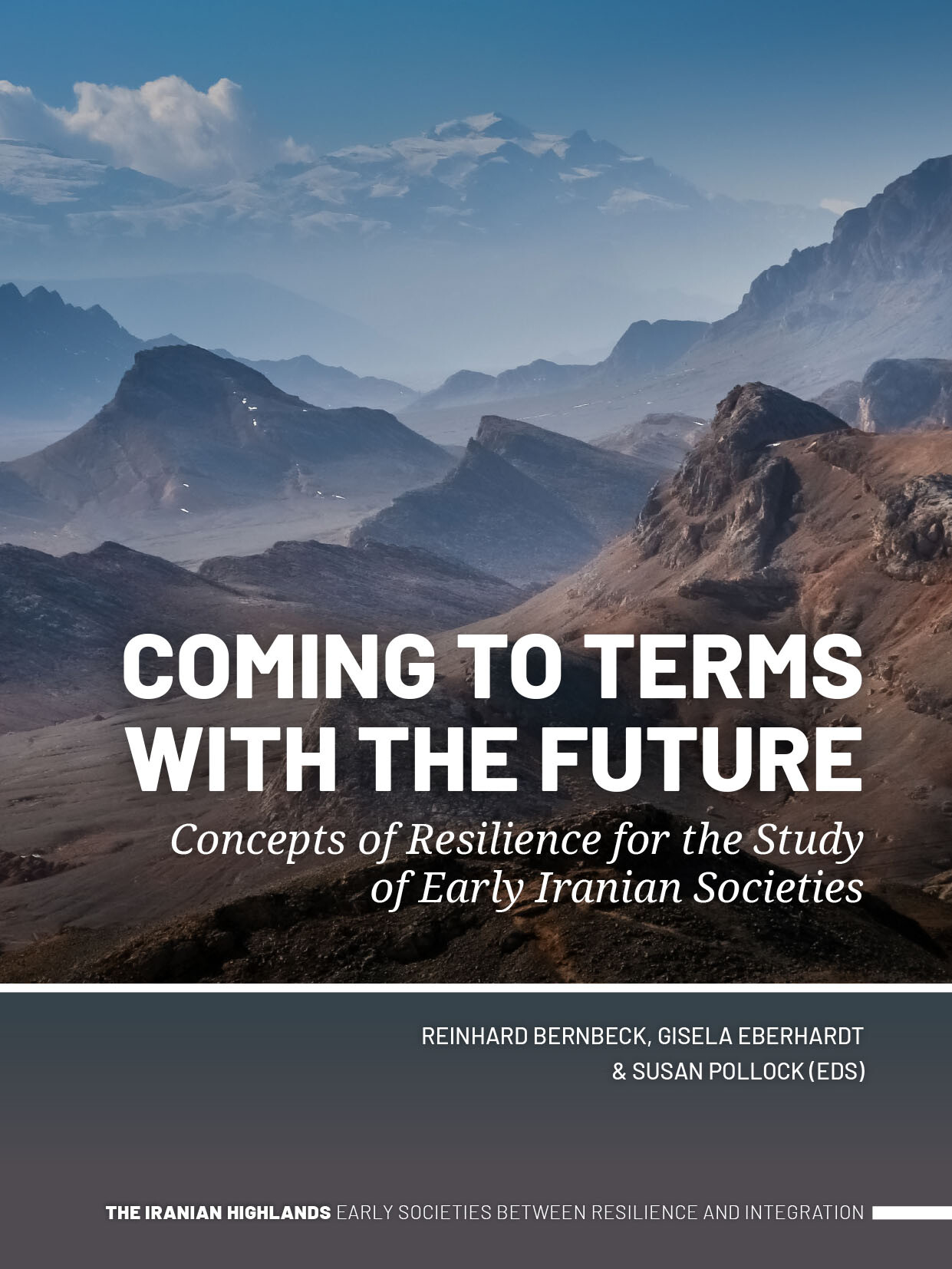 | Bernbeck, Reinhard; Eberhardt, Gisela; Pollock, Susan (Ed.): Coming to Terms with the Future. Concepts of Resilience for the Study of Early Iranian Societies. Sidestone Press, Leiden, 2023, ISBN: 9789464261462. @book{nokey,
title = {Coming to Terms with the Future. Concepts of Resilience for the Study of Early Iranian Societies},
editor = {Reinhard Bernbeck and Gisela Eberhardt and Susan Pollock},
url = {https://www.sidestone.com/books/coming-to-terms-with-the-future},
isbn = {9789464261462},
year = {2023},
date = {2023-03-22},
urldate = {2023-03-22},
booktitle = {Coming to Terms with the Future. Concepts of Resilience for the Study of Early Iranian Societies. The Iranian Highlands. Early Societies between Resilience and Integration 1},
publisher = {Sidestone Press},
address = {Leiden},
abstract = {The collection of essays in this book focuses on the highlands of Iran in pre-modern times, reaching from the Paleolithic to the medieval period. What holds the diverse contributions together is an issue that is closely related to debates in our own times: crises and how societies in the past dealt with them. We start from the premise that general circumstances in the fractured topographic structure of the Iranian highlands led to unique relations between ecological, social, economic and political conditions.
In three sections entitled “Climate and palaeoenvironment”, “Settlement, subsistence and mobility” und “Political and economic institutions”, the authors ask what sorts of crises afflicted past societies in the Iranian highlands, to what extent they proved resilient, and especially what strategies they developed for enhancing the resilience of their ways of life. Looking for answers in paleoenvironmental proxy data, archaeological findings and written sources, the authors examine subsistence economies, political institutions, religious beliefs, everyday routines and economic specialization in different temporal, spatial and organizational scales.
This book is the first volume of a series published by the German-Iranian research cooperation “The Iranian Highlands: Resiliences and Integration in Premodern Societies”. The goal of the research project is to shine a new light on communities and societies that populated the Iranian highlands and their more or less successful strategies to cope with the many vagaries, the constant changes and risks of their natural and humanly shaped environments.
CONTENTS
Climate and palaeoenvironment
Holocene Paleoenvironmental Change and Phases of Drought in the Iranian Highlands. A Review
Martin Kehl, Babak Rafiei-Alavi, Hamid Alizadeh Ketek Lahijani
The Impact of Climate on Human Occupations in Iran from the Neolithic to the Early Iron Age: An Attempt to Link Archaeological and Paleoclimate Records
Babak Rafiei-Alavi, Martin Kehl, Hamid Alizadeh Ketek Lahijani
Evidence of Neanderthal Resilience from Forty-five to Thirty-nine Thousand Years Ago at the Bawa Yawan Rockshelter, Kermanshah, Zagros Highlands
Saman Heydari-Guran, Nemat Hariri, Martin Kehl, Samran Asiabani, Faramarz Azizi, Elham Ghasidian
Water Stress and Imperial Politics in the Southern Zagros Mountains: An Interdisciplinary Approach in Long-Term Perspective
Andrea Ricci, Silvia Balatti, Elodie Brisset, Morteza Djamali, Abdolmajid Naderi Beni, Ahmad Azadi, Pejman Firoozbakhsh
Settlement, subsistence and mobility
Resilience in Practice: A View from the Kura-Araxes Cultural Tradition in Iran
Sepideh Maziar
Reaching the Breaking Point? Developments in the Chalcolithic to Early Bronze Age Varamin Plain
Susan Pollock, Morteza Hessari, Reinhard Bernbeck
The Bronze and Iron Age of Mazandaran (3200–1000 BCE): Resilience and Cultural Adaptability
Hassan Fazeli Nashli, Mojtaba Safari, Yunshi Huang, Zhenhua Deng, Hadi Davoudi, Xiaohong Wu
The Environmental Limitations for the Pastoral-Nomadic Way of Life in the Karadagh Highlands of Northwestern Iran: Evidence from the Iron Age I-II and Modern Times
Bahram Ajorloo
Political and economic institutions
Second-Year Cows for Manlari. Elamite State Investment in Cattle Husbandry in the Southern Zagros Mountains
Azam Rayat and Walther Sallaberger
Coping with Problems of Mining: Approaching Resilience Strategies through the Study of Resource-Scapes in the Iranian Highlands
Thomas Stöllner
Imperial Control and Highland Resilience in the Parthian Zagros
Michael Brown and Shelir Amelirad
Resilience in Centralized State Systems. The Persepolis Fortification Archive and Achaemenid Institutional Longevity
Wouter F. M. Henkelman, Kai Kaniuth, Kourosh Mohammadkhani
Prestigious Building and Urban Development in Ilkhanid Iran: The Rabʿ-i Rashīdī in Tabrīz as an Example of Resilience and Vulnerability in a Long-Term Perspective
Birgitt Hoffmann, Lorenz Korn, Thomas Lorain, Jonas Elbers, Maryam Moeini
Dynamics of Development and Resilience in Western Fars: The Bozpar Valley
Stefan R. Hauser, Giuseppe Labisi, Elnaz Rashidian},
keywords = {Administration, Economy, Environmental conditions, Institutions, Integration, Mobility, Resilience, Resources, Settlement and subsistance systems, Structure development},
pubstate = {published},
tppubtype = {book}
}
The collection of essays in this book focuses on the highlands of Iran in pre-modern times, reaching from the Paleolithic to the medieval period. What holds the diverse contributions together is an issue that is closely related to debates in our own times: crises and how societies in the past dealt with them. We start from the premise that general circumstances in the fractured topographic structure of the Iranian highlands led to unique relations between ecological, social, economic and political conditions.
In three sections entitled “Climate and palaeoenvironment”, “Settlement, subsistence and mobility” und “Political and economic institutions”, the authors ask what sorts of crises afflicted past societies in the Iranian highlands, to what extent they proved resilient, and especially what strategies they developed for enhancing the resilience of their ways of life. Looking for answers in paleoenvironmental proxy data, archaeological findings and written sources, the authors examine subsistence economies, political institutions, religious beliefs, everyday routines and economic specialization in different temporal, spatial and organizational scales.
This book is the first volume of a series published by the German-Iranian research cooperation “The Iranian Highlands: Resiliences and Integration in Premodern Societies”. The goal of the research project is to shine a new light on communities and societies that populated the Iranian highlands and their more or less successful strategies to cope with the many vagaries, the constant changes and risks of their natural and humanly shaped environments.
CONTENTS
Climate and palaeoenvironment
Holocene Paleoenvironmental Change and Phases of Drought in the Iranian Highlands. A Review
Martin Kehl, Babak Rafiei-Alavi, Hamid Alizadeh Ketek Lahijani
The Impact of Climate on Human Occupations in Iran from the Neolithic to the Early Iron Age: An Attempt to Link Archaeological and Paleoclimate Records
Babak Rafiei-Alavi, Martin Kehl, Hamid Alizadeh Ketek Lahijani
Evidence of Neanderthal Resilience from Forty-five to Thirty-nine Thousand Years Ago at the Bawa Yawan Rockshelter, Kermanshah, Zagros Highlands
Saman Heydari-Guran, Nemat Hariri, Martin Kehl, Samran Asiabani, Faramarz Azizi, Elham Ghasidian
Water Stress and Imperial Politics in the Southern Zagros Mountains: An Interdisciplinary Approach in Long-Term Perspective
Andrea Ricci, Silvia Balatti, Elodie Brisset, Morteza Djamali, Abdolmajid Naderi Beni, Ahmad Azadi, Pejman Firoozbakhsh
Settlement, subsistence and mobility
Resilience in Practice: A View from the Kura-Araxes Cultural Tradition in Iran
Sepideh Maziar
Reaching the Breaking Point? Developments in the Chalcolithic to Early Bronze Age Varamin Plain
Susan Pollock, Morteza Hessari, Reinhard Bernbeck
The Bronze and Iron Age of Mazandaran (3200–1000 BCE): Resilience and Cultural Adaptability
Hassan Fazeli Nashli, Mojtaba Safari, Yunshi Huang, Zhenhua Deng, Hadi Davoudi, Xiaohong Wu
The Environmental Limitations for the Pastoral-Nomadic Way of Life in the Karadagh Highlands of Northwestern Iran: Evidence from the Iron Age I-II and Modern Times
Bahram Ajorloo
Political and economic institutions
Second-Year Cows for Manlari. Elamite State Investment in Cattle Husbandry in the Southern Zagros Mountains
Azam Rayat and Walther Sallaberger
Coping with Problems of Mining: Approaching Resilience Strategies through the Study of Resource-Scapes in the Iranian Highlands
Thomas Stöllner
Imperial Control and Highland Resilience in the Parthian Zagros
Michael Brown and Shelir Amelirad
Resilience in Centralized State Systems. The Persepolis Fortification Archive and Achaemenid Institutional Longevity
Wouter F. M. Henkelman, Kai Kaniuth, Kourosh Mohammadkhani
Prestigious Building and Urban Development in Ilkhanid Iran: The Rabʿ-i Rashīdī in Tabrīz as an Example of Resilience and Vulnerability in a Long-Term Perspective
Birgitt Hoffmann, Lorenz Korn, Thomas Lorain, Jonas Elbers, Maryam Moeini
Dynamics of Development and Resilience in Western Fars: The Bozpar Valley
Stefan R. Hauser, Giuseppe Labisi, Elnaz Rashidian |
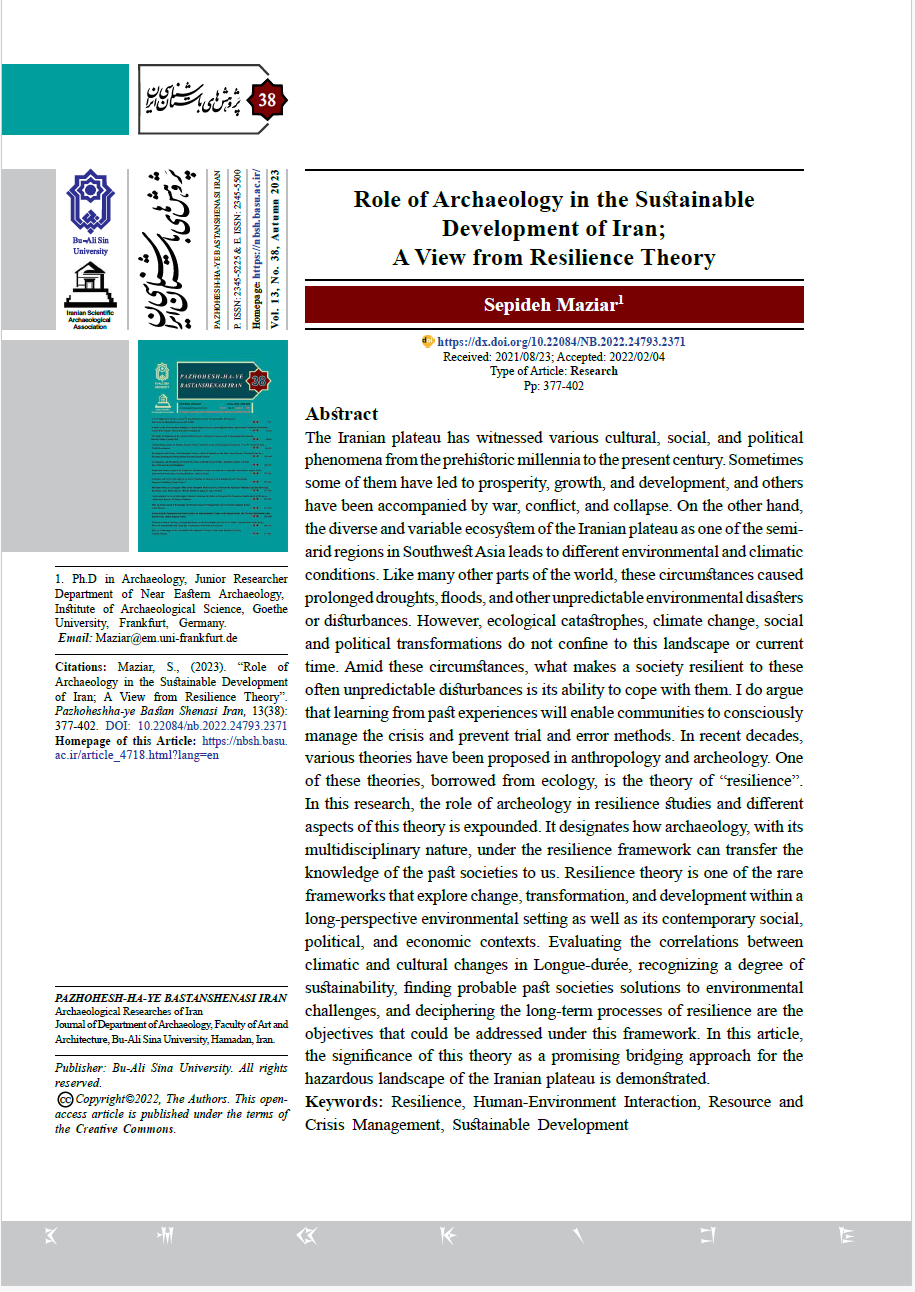 | Maziar, Sepideh: Role of Archaeology in the Sustainable Development of Iran; A View from Resilience Theory. In: Pazhoheshha-ye Bastan Shenasi Iran, vol. 13, no. 38, pp. 377-402, 2023. @article{nokey,
title = {Role of Archaeology in the Sustainable Development of Iran; A View from Resilience Theory},
author = {Sepideh Maziar},
url = {https://iranhighlands.com/wp-content/uploads/2024/05/Maziar.2024.Resilience-and-Sustainability.pdf},
doi = {10.22084/nb.2022.24793.2371},
year = {2023},
date = {2023-01-01},
urldate = {2023-01-01},
journal = {Pazhoheshha-ye Bastan Shenasi Iran},
volume = {13},
number = {38},
pages = {377-402},
abstract = {The Iranian plateau has witnessed various cultural, social, and political phenomena from the prehistoric millennia to the present century. Sometimes some of them have led to prosperity, growth, and development, and others have been accompanied by war, conflict, and collapse. On the other hand, the diverse and variable ecosystem of the Iranian plateau as one of the semiarid regions in Southwest Asia leads to different environmental and climatic conditions. Like many other parts of the world, these circumstances caused prolonged droughts, floods, and other unpredictable environmental disasters or disturbances. However, ecological catastrophes, climate change, social and political transformations do not confine to this landscape or current time. Amid these circumstances, what makes a society resilient to these often unpredictable disturbances is its ability to cope with them. I do argue that learning from past experiences will enable communities to consciously manage the crisis and prevent trial and error methods. In recent decades, various theories have been proposed in anthropology and archeology. One of these theories, borrowed from ecology, is the theory of “resilience”. In this research, the role of archeology in resilience studies and different aspects of this theory is expounded. It designates how archaeology, with its multidisciplinary nature, under the resilience framework can transfer the knowledge of the past societies to us. Resilience theory is one of the rare frameworks that explore change, transformation, and development within a long-perspective environmental setting as well as its contemporary social, political, and economic contexts. Evaluating the correlations between climatic and cultural changes in Longue-durée, recognizing a degree of sustainability, finding probable past societies solutions to environmental challenges, and deciphering the long-term processes of resilience are the objectives that could be addressed under this framework. In this article, the significance of this theory as a promising bridging approach for the hazardous landscape of the Iranian plateau is demonstrated. },
keywords = {Crisis, Resilience, Resources, Sustainability},
pubstate = {published},
tppubtype = {article}
}
The Iranian plateau has witnessed various cultural, social, and political phenomena from the prehistoric millennia to the present century. Sometimes some of them have led to prosperity, growth, and development, and others have been accompanied by war, conflict, and collapse. On the other hand, the diverse and variable ecosystem of the Iranian plateau as one of the semiarid regions in Southwest Asia leads to different environmental and climatic conditions. Like many other parts of the world, these circumstances caused prolonged droughts, floods, and other unpredictable environmental disasters or disturbances. However, ecological catastrophes, climate change, social and political transformations do not confine to this landscape or current time. Amid these circumstances, what makes a society resilient to these often unpredictable disturbances is its ability to cope with them. I do argue that learning from past experiences will enable communities to consciously manage the crisis and prevent trial and error methods. In recent decades, various theories have been proposed in anthropology and archeology. One of these theories, borrowed from ecology, is the theory of “resilience”. In this research, the role of archeology in resilience studies and different aspects of this theory is expounded. It designates how archaeology, with its multidisciplinary nature, under the resilience framework can transfer the knowledge of the past societies to us. Resilience theory is one of the rare frameworks that explore change, transformation, and development within a long-perspective environmental setting as well as its contemporary social, political, and economic contexts. Evaluating the correlations between climatic and cultural changes in Longue-durée, recognizing a degree of sustainability, finding probable past societies solutions to environmental challenges, and deciphering the long-term processes of resilience are the objectives that could be addressed under this framework. In this article, the significance of this theory as a promising bridging approach for the hazardous landscape of the Iranian plateau is demonstrated. |
 | Hummel, Jakob: Softwaregestützte Modellierung der Wasserversorgungsinfrastruktur des iranischen Dorfes Hamzehloo. Technische Universität Darmstadt, Darmstadt. IWAR, Fachgebiet Wasserversorgung und Grundwasserschutz, 2023. @mastersthesis{nokey,
title = {Softwaregestützte Modellierung der Wasserversorgungsinfrastruktur des iranischen Dorfes Hamzehloo},
author = {Jakob Hummel},
url = {https://iranhighlands.com/wp-content/uploads/2023/11/MA_Hummel_Wasserprojekt_kompr_unkenntl.pdf},
year = {2023},
date = {2023-00-00},
urldate = {2023-00-00},
school = {Technische Universität Darmstadt, Darmstadt. IWAR, Fachgebiet Wasserversorgung und Grundwasserschutz},
abstract = {The planning and modelling of Hamzehloo's water supply infrastructure are based on the original
concept from 2019. Current findings obtained during the campaigns in 2022 result in three relevant
changes. Firstly, the location of the water treatment plant building is changing, which also results in
changes regarding the route. The second change is the deepening of the Reza abaad well. This also
results in a new extension of the well due to the pile driving process. The third point is the slight
reduction of the pipe diameter of the service water pipe to DN 75.
The water supply infrastructure includes the well house, the reservoir, the water treatment building
and the piping network. In addition to the Iranian regulations, the construction of the structures is
also based on the DVGW regulations as well as many DIN standards in order to achieve the best
results and to ensure structural stability. Although the focus is on local construction methods, new
elements, such as flood protection for the well house, are also integrated into the planning.
In order to make the desired design clear to all project participants, detailed digital models are created
of the buildings as well as of the entire village. Three software applications are used for the modelling.
The creation of individual components is done with Fusion 360. These components are then imported
into the building models, which are constructed with Revit. InfraWorks combines all components in
a digital terrain model, which implies the village and its surroundings. Finally, the buildings of the
water supply infrastructure are connected to the route. In addition, a model of the planned visitor
centre is created.
},
keywords = {Water},
pubstate = {published},
tppubtype = {mastersthesis}
}
The planning and modelling of Hamzehloo's water supply infrastructure are based on the original
concept from 2019. Current findings obtained during the campaigns in 2022 result in three relevant
changes. Firstly, the location of the water treatment plant building is changing, which also results in
changes regarding the route. The second change is the deepening of the Reza abaad well. This also
results in a new extension of the well due to the pile driving process. The third point is the slight
reduction of the pipe diameter of the service water pipe to DN 75.
The water supply infrastructure includes the well house, the reservoir, the water treatment building
and the piping network. In addition to the Iranian regulations, the construction of the structures is
also based on the DVGW regulations as well as many DIN standards in order to achieve the best
results and to ensure structural stability. Although the focus is on local construction methods, new
elements, such as flood protection for the well house, are also integrated into the planning.
In order to make the desired design clear to all project participants, detailed digital models are created
of the buildings as well as of the entire village. Three software applications are used for the modelling.
The creation of individual components is done with Fusion 360. These components are then imported
into the building models, which are constructed with Revit. InfraWorks combines all components in
a digital terrain model, which implies the village and its surroundings. Finally, the buildings of the
water supply infrastructure are connected to the route. In addition, a model of the planned visitor
centre is created.
|
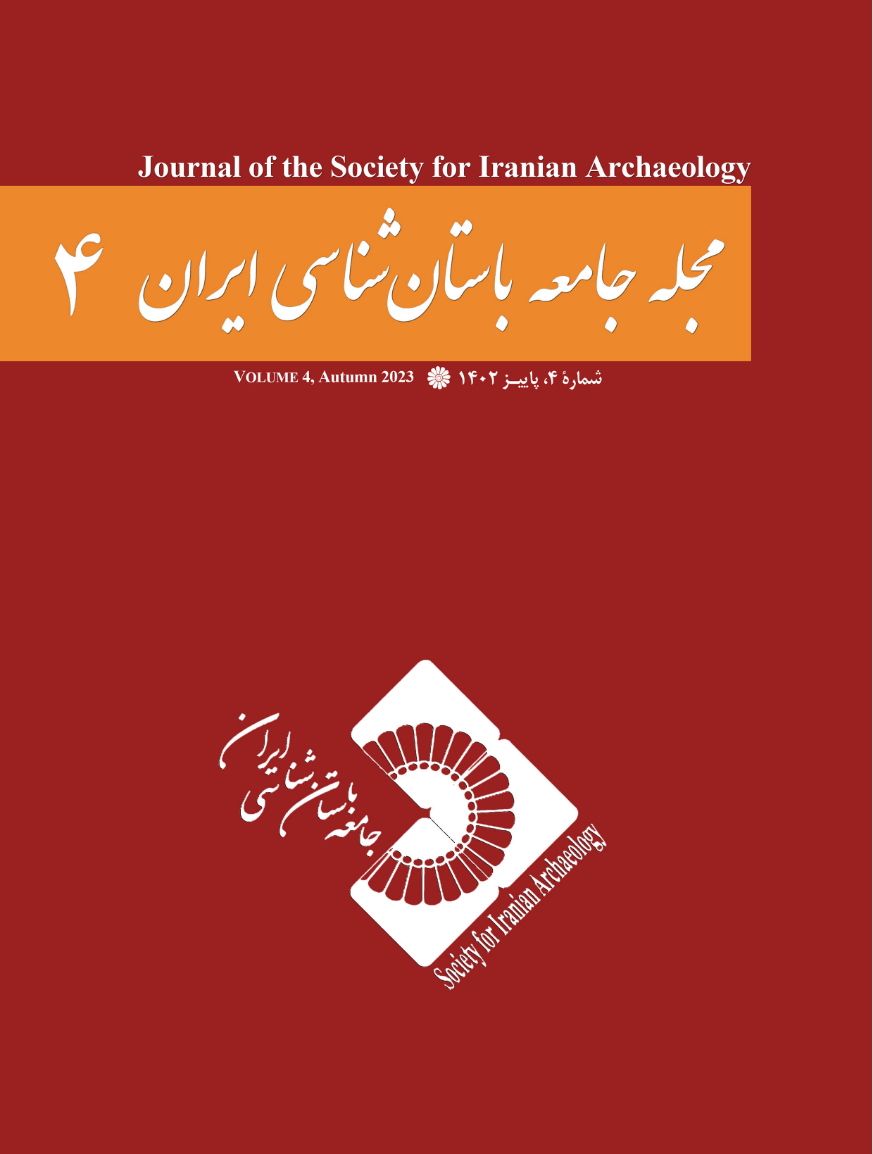 | Maziar, Sepideh: Sustainability and Resilience in Iran: A View from Archaeology. In: Journal of the Society for Iranian Archaeology, vol. 2023, iss. 4, 2023. @article{nokey,
title = {Sustainability and Resilience in Iran: A View from Archaeology},
author = {Sepideh Maziar},
url = {https://www.academia.edu/111261166/Sustainability_and_Resilience_in_Iran_A_View_from_Archaeology},
year = {2023},
date = {2023-00-00},
urldate = {2023-00-00},
journal = {Journal of the Society for Iranian Archaeology},
volume = {2023},
issue = {4},
publisher = {Society for Iranian Archaeology},
abstract = {With increasing awareness of climate change, war and conflicts, social inequalities, and environmental crises, there has been a growing interest in concepts such as sustainable development and resilience. This shift has also found its place in various scientific disciplines, including archaeology. The ability of societies to withstand these unpredictable changes lies in their knowledge of effective strategies to navigate such conditions. This knowledge and experience can empower us to consciously manage resources, effectively address crises, and adapt to the ever-changing circumstances of the modern world. These approaches are still relatively new and not as widely recognized as they should be. Consequently, this article aims to introduce the resilience approach and explore its application in archaeology. It delves into the background of the term, provides a general definition, and presents various interdisciplinary approaches associated with this framework. Given the current conditions in Iran, embracing these interdisciplinary and multidimensional approaches can transform archaeology to resonate with society. Moreover, it establishes a vital connection between the past and the present of Iran.},
keywords = {Resilience, Sustainability},
pubstate = {published},
tppubtype = {article}
}
With increasing awareness of climate change, war and conflicts, social inequalities, and environmental crises, there has been a growing interest in concepts such as sustainable development and resilience. This shift has also found its place in various scientific disciplines, including archaeology. The ability of societies to withstand these unpredictable changes lies in their knowledge of effective strategies to navigate such conditions. This knowledge and experience can empower us to consciously manage resources, effectively address crises, and adapt to the ever-changing circumstances of the modern world. These approaches are still relatively new and not as widely recognized as they should be. Consequently, this article aims to introduce the resilience approach and explore its application in archaeology. It delves into the background of the term, provides a general definition, and presents various interdisciplinary approaches associated with this framework. Given the current conditions in Iran, embracing these interdisciplinary and multidimensional approaches can transform archaeology to resonate with society. Moreover, it establishes a vital connection between the past and the present of Iran. |
2022
|
 | Maziar, Sepideh: Evaluation of the Kura-Araxes migration: From a mono-factorial phantasm to a multi-dimensional phenomenon. In: Kosyan, Aram; Avetisyan, Pavel; Martirosyan-Olshansky, Kristine; Bobokhyan, Arsen; Grekyan, Yervand (Ed.): Paradise Lost. The Phenomenon of the Kura-Araxes Tradition along the Fertile Crescent Collection of papers honouring Ruben S. Badalyan on the occassion of his 65th birthday, Archaeopress, 2022. @inbook{nokey,
title = {Evaluation of the Kura-Araxes migration: From a mono-factorial phantasm to a multi-dimensional phenomenon},
author = {Sepideh Maziar},
editor = {Aram Kosyan and Pavel Avetisyan and Kristine Martirosyan-Olshansky and Arsen Bobokhyan and Yervand Grekyan},
doi = {10.32028/ajnes.v16i1-2.1834},
year = {2022},
date = {2022-12-31},
booktitle = {Paradise Lost. The Phenomenon of the Kura-Araxes Tradition along the Fertile Crescent Collection of papers honouring Ruben S. Badalyan on the occassion of his 65th birthday},
journal = {ARAMAZD. Armenian Journal of Near Eastern Studies (AJNES)},
publisher = {Archaeopress},
abstract = {Many scholars concerned with the Kura-Araxes cultural tradition take many aspects of this complex phenomenon for granted. In most publications, the expansion of this tradition across a vast area is treated like the movement of people from point A to B, or in the best case, as the waves of movement between these points. In most of them, migration is considered a direct reaction of people to population growth, lack of pasture lands, environmental stresses, and the Kura-Araxes as environmental or conflict refugees that flee a threat. These perspectives in recent years terminated to some skeptics regarding considering the distribution of the Kura-Araxes material culture as a result of migration. On the other hand, turning to be once again a buzzword, ‘migration’ as an explanation, is considered anachronistic among some archaeologists. This article will reevaluate different scenarios related to the Kura-Araxes phenomenon to see where we stand and how we can overcome these shortcomings. It seems that the Kura-Araxes phenomenon at the current state of our understanding suffers different drawbacks at different levels. The migration scenario itself and the mechanism behind it are still vague, and the relationship between the core area and diaspora is rarely addressed. It is suggested that approaches such as ‘resilience theory’ and discussing the Kura- Araxes phenomenon and migration in the context of social resilience will be more promising for the topic at hand.},
keywords = {Bronze Age, Kura-Araxes, Mobility, Resilience, Translocality},
pubstate = {published},
tppubtype = {inbook}
}
Many scholars concerned with the Kura-Araxes cultural tradition take many aspects of this complex phenomenon for granted. In most publications, the expansion of this tradition across a vast area is treated like the movement of people from point A to B, or in the best case, as the waves of movement between these points. In most of them, migration is considered a direct reaction of people to population growth, lack of pasture lands, environmental stresses, and the Kura-Araxes as environmental or conflict refugees that flee a threat. These perspectives in recent years terminated to some skeptics regarding considering the distribution of the Kura-Araxes material culture as a result of migration. On the other hand, turning to be once again a buzzword, ‘migration’ as an explanation, is considered anachronistic among some archaeologists. This article will reevaluate different scenarios related to the Kura-Araxes phenomenon to see where we stand and how we can overcome these shortcomings. It seems that the Kura-Araxes phenomenon at the current state of our understanding suffers different drawbacks at different levels. The migration scenario itself and the mechanism behind it are still vague, and the relationship between the core area and diaspora is rarely addressed. It is suggested that approaches such as ‘resilience theory’ and discussing the Kura- Araxes phenomenon and migration in the context of social resilience will be more promising for the topic at hand. |
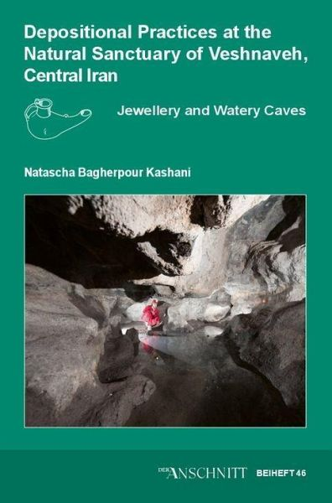 | Kashani, Natascha Bagherpour: Depositional Practices at the Natural Sanctuary of Veshnaveh, Central Iran: Jewellery and Watery Caves. Verlag Marie Leidorf, Rahden/Westfalen, 2022. @book{nokey,
title = {Depositional Practices at the Natural Sanctuary of Veshnaveh, Central Iran: Jewellery and Watery Caves},
author = {Natascha Bagherpour Kashani},
url = {https://www.academia.edu/74606881/Depositional_Practices_at_the_Natural_Sanctuary_of_Veshnaveh_Central_Iran_with_a_contribution_on_glass_analysis_by_James_Lankton_and_Bernard_Gratuze},
year = {2022},
date = {2022-00-00},
urldate = {2022-00-00},
publisher = {Verlag Marie Leidorf},
address = {Rahden/Westfalen},
series = {Mining Archaeology in Iran 1 },
abstract = {The mining archaeological excavations in Veshnaveh were among the first systematic of their kind in Iran. This is surprising, since the site itself had been known and described since the 1970s, but could not be investigated thoroughly until the early 2000s. The joint Iranian-German research in Veshnaveh was carried out as a part of the “Early Min- ing and Metallurgy in West-Central Iran” project, which had been continued until 2005. In this context, the mining area of Veshnaveh was comprehensively researched and, for the first time, underground excavations and surveys were carried out in the vicinity of the mining area. During our research of the mining evidence, it was the more surprising to discover ritual re-use of a Bronze Age copper mine. The excavations from 2001 onwards made it immediately clear that these deposits were not part of mining debris as one would have expected for mining activities. The findings suggested a different con- text and it was clear that this was a special rural sanc- tuary of pre- and early Zoroastrian cults.},
keywords = {Bronze Age, Copper, copper base, Metal Resources, Mining, Qom, Religious structures, Resources},
pubstate = {published},
tppubtype = {book}
}
The mining archaeological excavations in Veshnaveh were among the first systematic of their kind in Iran. This is surprising, since the site itself had been known and described since the 1970s, but could not be investigated thoroughly until the early 2000s. The joint Iranian-German research in Veshnaveh was carried out as a part of the “Early Min- ing and Metallurgy in West-Central Iran” project, which had been continued until 2005. In this context, the mining area of Veshnaveh was comprehensively researched and, for the first time, underground excavations and surveys were carried out in the vicinity of the mining area. During our research of the mining evidence, it was the more surprising to discover ritual re-use of a Bronze Age copper mine. The excavations from 2001 onwards made it immediately clear that these deposits were not part of mining debris as one would have expected for mining activities. The findings suggested a different con- text and it was clear that this was a special rural sanc- tuary of pre- and early Zoroastrian cults. |
 | Labisi, Guiseppe: Squinches and Semi-domes Between the Late Sasanian and Early Islamic Periods. In: Iran: Journal of the British Institute of Persian Studies, iss. 28, no. 2, pp. 236-49, 2022. @article{nokey,
title = {Squinches and Semi-domes Between the Late Sasanian and Early Islamic Periods},
author = {Guiseppe Labisi},
doi = {https://doi.org/10.1080/05786967.2019.1633241},
year = {2022},
date = {2022-00-00},
urldate = {2022-00-00},
journal = {Iran: Journal of the British Institute of Persian Studies},
number = {2},
issue = {28},
pages = {236-49},
abstract = {The aim of this paper is to present a first attempt at a comprehensive classification of squinches related to semi-domes, in Persian kāna pūsh, in Greater Syria, Mesopotamia and Iran between the late Sasanian and early Islamic periods. This feature is a characteristic of the Persian architectural tradition: all the preserved examples are in buildings of considerable importance (most are related to the architecture of the élites) and demonstrate a typological evolution. Furthermore, their origin can also be backdated to between the late Sasanian and early Islamic periods.},
keywords = {Architecture, Islamic era, Sasanian, Social, social relations, Syria},
pubstate = {published},
tppubtype = {article}
}
The aim of this paper is to present a first attempt at a comprehensive classification of squinches related to semi-domes, in Persian kāna pūsh, in Greater Syria, Mesopotamia and Iran between the late Sasanian and early Islamic periods. This feature is a characteristic of the Persian architectural tradition: all the preserved examples are in buildings of considerable importance (most are related to the architecture of the élites) and demonstrate a typological evolution. Furthermore, their origin can also be backdated to between the late Sasanian and early Islamic periods. |
 | Aali, Abolfazl; Mostafapour, Iman; Zifar, Hamed; Stöllner, Thomas: Stratigraphical Excavations at Tappeh Kūzehchi, Zanjan Province. In: Proceedings of the 19th Annual Symposium of Iranian Archaeology, pp. 655-62, National Museum of Iran, Tehran, 2022. @inbook{nokey,
title = {Stratigraphical Excavations at Tappeh Kūzehchi, Zanjan Province},
author = {Abolfazl Aali and Iman Mostafapour and Hamed Zifar and Thomas Stöllner},
year = {2022},
date = {2022-00-00},
urldate = {2022-00-00},
booktitle = {Proceedings of the 19th Annual Symposium of Iranian Archaeology},
pages = {655-62},
publisher = {National Museum of Iran},
address = {Tehran},
keywords = {Zanjan},
pubstate = {published},
tppubtype = {inbook}
}
|
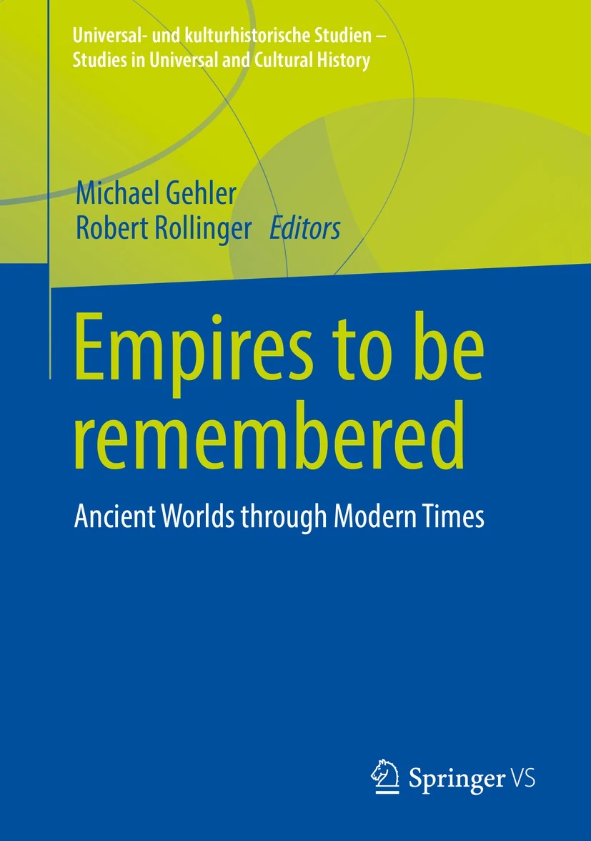 | Hoffmann, Birgitt: The Mongol Ilkhanate of Iran: Realm or Empire?. In: Gehler, Michael; Rollinger, Robert (Ed.): Empires to be Remembered. Ancient World through Modern Times, pp. 355-365, Springer, Wiesbaden, 2022, ISSN: 2524-3780. @inbook{nokey,
title = {The Mongol Ilkhanate of Iran: Realm or Empire?},
author = {Birgitt Hoffmann},
editor = {Michael Gehler and Robert Rollinger},
doi = {https://doi.org/10.1007/978-3-658-34003-2},
issn = {2524-3780},
year = {2022},
date = {2022-00-00},
urldate = {2022-00-00},
booktitle = {Empires to be Remembered. Ancient World through Modern Times},
pages = {355-365},
publisher = {Springer},
address = {Wiesbaden},
keywords = {Ilkhanate, Islamic era, Mongols},
pubstate = {published},
tppubtype = {inbook}
}
|
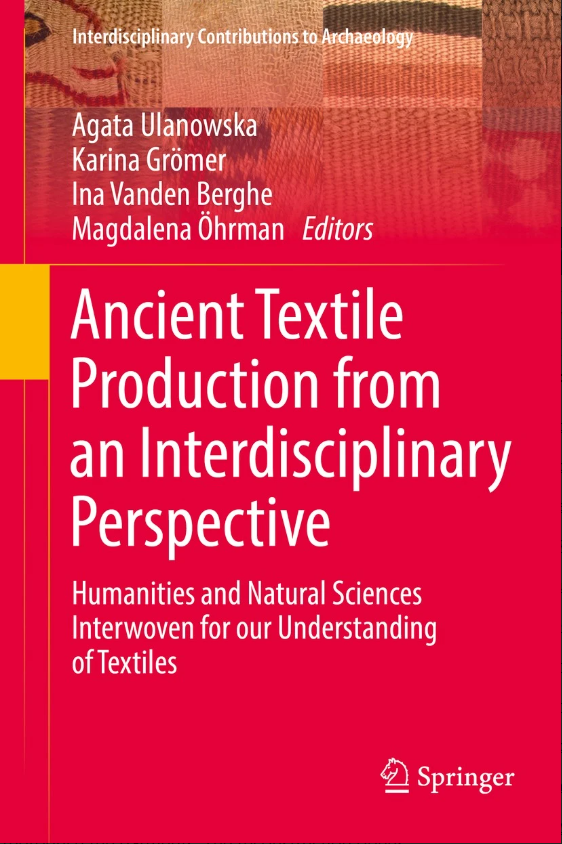 | Moskvin, Aleksei; Grömer, Karina; Moskvina, Mariia; Kuzmichev, Victor; Stöllner, Thomas; Aali, Abolfazl: 3D Visualization of the 2400-Year-Old Garments of Salt Man 4 from Chehrābād, Iran.. In: Ulanowska, Agata; Grömer, Karina; Berghe, Ina Vanden; Öhrman, Magdalena (Ed.): Ancient Textile Production from an Interdisciplinary Perspective, Springer, Cham, 2022, ISBN: 978-3-030-92170-5. @inbook{nokey,
title = {3D Visualization of the 2400-Year-Old Garments of Salt Man 4 from Chehrābād, Iran.},
author = {Aleksei Moskvin and Karina Grömer and Mariia Moskvina and Victor Kuzmichev and Thomas Stöllner and Abolfazl Aali},
editor = {Agata Ulanowska and Karina Grömer and Ina Vanden Berghe and Magdalena Öhrman},
doi = {https://doi.org/10.1007/978-3-030-92170-5_18},
isbn = {978-3-030-92170-5},
year = {2022},
date = {2022-00-00},
urldate = {2022-00-00},
booktitle = {Ancient Textile Production from an Interdisciplinary Perspective},
publisher = {Springer},
address = {Cham},
series = {Interdisciplinary Contributions to Archaeology},
keywords = {Achaemenid, Mining, Organic remains, Zanjan},
pubstate = {published},
tppubtype = {inbook}
}
|
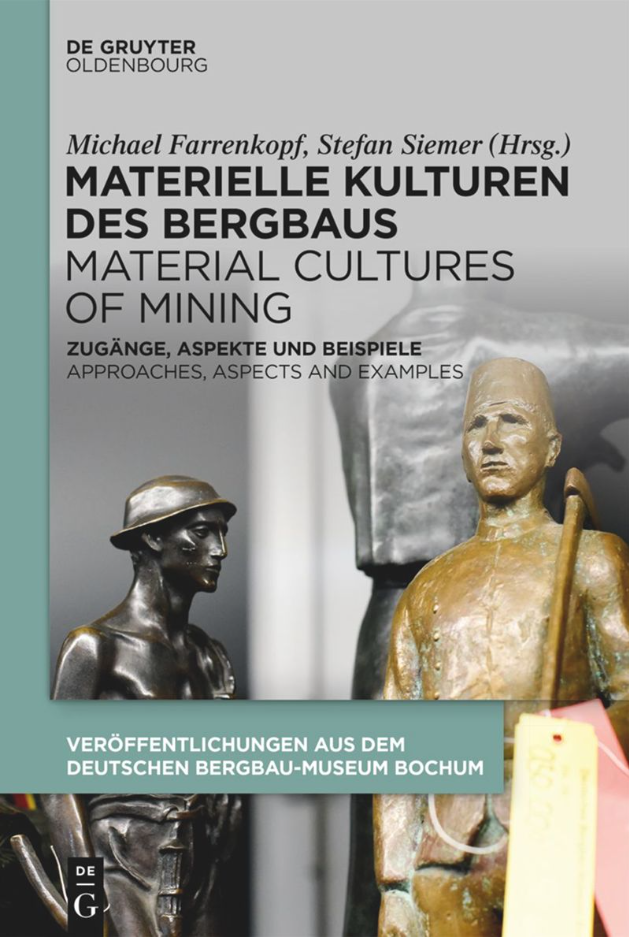 | Stöllner, Thomas: Entangled Connections: Materialized Practices of Knowledge-Networks of Mining: From the Theoretical Level to its Empirical Consequences in Mining Archaeology.. In: Farrenkopf, Michael; Siemer, Stefan (Ed.): Materielle Kulturen des Bergbaus – Material Cultures of Mining: Zugänge, Aspekte und Beispiele – Approaches, Aspects and Examples, pp. 317-344, De Gruyter Oldenbourg, Berlin and Boston, 2022. @inbook{nokey,
title = {Entangled Connections: Materialized Practices of Knowledge-Networks of Mining: From the Theoretical Level to its Empirical Consequences in Mining Archaeology.},
author = {Thomas Stöllner},
editor = {Michael Farrenkopf and Stefan Siemer},
doi = {https://doi.org/10.1515/9783110729955},
year = {2022},
date = {2022-00-00},
urldate = {2022-00-00},
booktitle = {Materielle Kulturen des Bergbaus – Material Cultures of Mining: Zugänge, Aspekte und Beispiele – Approaches, Aspects and Examples},
pages = {317-344},
publisher = {De Gruyter Oldenbourg},
address = {Berlin and Boston},
series = {Veröffentlichungen aus dem Deutschen Bergbau-Museum Bochum 243},
keywords = {Minerals, Mining, Resources, Social, social relations},
pubstate = {published},
tppubtype = {inbook}
}
|
 | Rol, Nolwen; Bernbeck, Reinhard; Wolff-Heger, Lisa; Akbari, Hassan; Hessari, Morteza; Pollock, Susan; Schäfer, Daniel: Chalcolithic Painted Pottery of the Sialk III Period: Quantifying Stylistic Continuities and Changes on the Northern Central Plateau. In: Iran. Journal of the British Institute of Persian Studies, 2022. @article{nokey,
title = {Chalcolithic Painted Pottery of the Sialk III Period: Quantifying Stylistic Continuities and Changes on the Northern Central Plateau},
author = {Nolwen Rol and Reinhard Bernbeck and Lisa Wolff-Heger and Hassan Akbari and Morteza Hessari and Susan Pollock and Daniel Schäfer},
doi = {https://doi.org/10.1080/05786967.2022.2101937},
year = {2022},
date = {2022-00-00},
urldate = {2022-00-00},
journal = {Iran. Journal of the British Institute of Persian Studies},
abstract = {In the last two decades, the Varamin Plain to the southeast of Tehran has been the focus of intensified archaeological work, with surveys and excavations yielding new insights into the region’s settlement history. New material from the dynamic network of Chalcolithic sites on the Jajrud alluvial fan now offers a more solid basis to assess the links between the Varamin Plain and the site of Tappeh Sialk in the Kashan Plain, which still remains a reference point for this period. In this paper, we use painted pottery to examine the dating and relationships of the settlements of Ahmadabad-e Kuzehgaran and Chaltasian on the Varamin Plain to Tappeh Sialk. Based on an in-depth quantitative analysis of motif assemblages at the three sites, we evaluate contemporaneities as well as stylistic similarities and differences. We highlight both shared temporal trends and regional specificities.},
keywords = {Chalcolithic, Pottery, Varamin Plain},
pubstate = {published},
tppubtype = {article}
}
In the last two decades, the Varamin Plain to the southeast of Tehran has been the focus of intensified archaeological work, with surveys and excavations yielding new insights into the region’s settlement history. New material from the dynamic network of Chalcolithic sites on the Jajrud alluvial fan now offers a more solid basis to assess the links between the Varamin Plain and the site of Tappeh Sialk in the Kashan Plain, which still remains a reference point for this period. In this paper, we use painted pottery to examine the dating and relationships of the settlements of Ahmadabad-e Kuzehgaran and Chaltasian on the Varamin Plain to Tappeh Sialk. Based on an in-depth quantitative analysis of motif assemblages at the three sites, we evaluate contemporaneities as well as stylistic similarities and differences. We highlight both shared temporal trends and regional specificities. |
2021
|
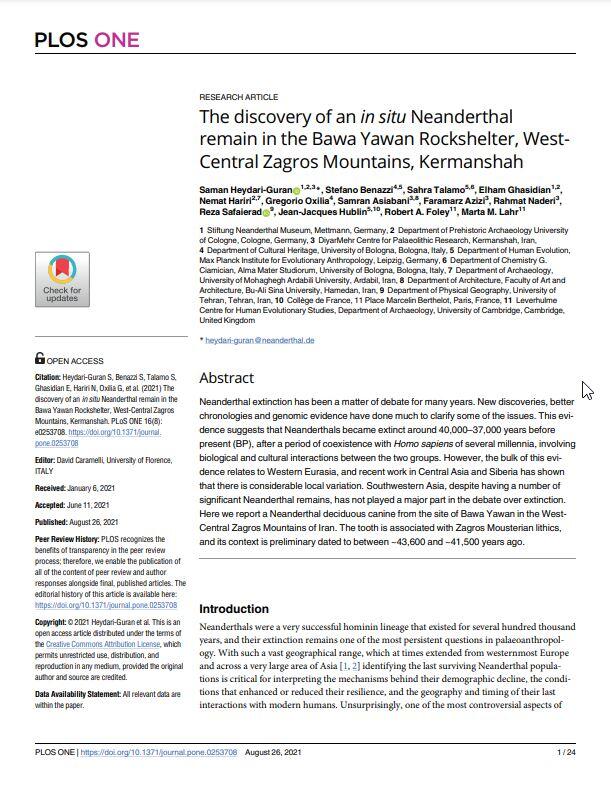 | Heydari-Guran, Saman; Benazzi, Stefano; Talamo, Sahra; Ghasidian, Elham; Hariri, Nemat; Oxilia, Gregorio; Asiabani, Samran; Azizi, Faramarz; Naderi, Rahmat; Safaierad, Reza; Hublin, Jean-Jacques; Foley, Robert A.; Lahr, Marta M.: The discovery of an in situ Neanderthal remain in the Bawa Yawan Rockshelter, West-Central Zagros Mountains, Kermanshah. In: PLoS ONE, vol. 16, no. 8, 2021. @article{nokey,
title = {The discovery of an in situ Neanderthal remain in the Bawa Yawan Rockshelter, West-Central Zagros Mountains, Kermanshah},
author = {Saman Heydari-Guran and Stefano Benazzi and Sahra Talamo and Elham Ghasidian and Nemat Hariri and Gregorio Oxilia and Samran Asiabani and Faramarz Azizi and Rahmat Naderi and Reza Safaierad and Jean-Jacques Hublin and Robert A. Foley and Marta M. Lahr},
editor = { David Caramelli},
url = {https://journals.plos.org/plosone/article?id=10.1371/journal.pone.0253708},
doi = {https://doi.org/10.1371/journal.pone.0253708},
year = {2021},
date = {2021-08-26},
urldate = {2021-08-26},
journal = {PLoS ONE},
volume = {16},
number = {8},
abstract = {Neanderthal extinction has been a matter of debate for many years. New discoveries, better chronologies and genomic evidence have done much to clarify some of the issues. This evidence suggests that Neanderthals became extinct around 40,000–37,000 years before present (BP), after a period of coexistence with Homo sapiens of several millennia, involving biological and cultural interactions between the two groups. However, the bulk of this evidence relates to Western Eurasia, and recent work in Central Asia and Siberia has shown that there is considerable local variation. Southwestern Asia, despite having a number of significant Neanderthal remains, has not played a major part in the debate over extinction. Here we report a Neanderthal deciduous canine from the site of Bawa Yawan in the West-Central Zagros Mountains of Iran. The tooth is associated with Zagros Mousterian lithics, and its context is preliminary dated to between ~43,600 and ~41,500 years ago.},
keywords = {Mousterian, Neanderthal, Zagros},
pubstate = {published},
tppubtype = {article}
}
Neanderthal extinction has been a matter of debate for many years. New discoveries, better chronologies and genomic evidence have done much to clarify some of the issues. This evidence suggests that Neanderthals became extinct around 40,000–37,000 years before present (BP), after a period of coexistence with Homo sapiens of several millennia, involving biological and cultural interactions between the two groups. However, the bulk of this evidence relates to Western Eurasia, and recent work in Central Asia and Siberia has shown that there is considerable local variation. Southwestern Asia, despite having a number of significant Neanderthal remains, has not played a major part in the debate over extinction. Here we report a Neanderthal deciduous canine from the site of Bawa Yawan in the West-Central Zagros Mountains of Iran. The tooth is associated with Zagros Mousterian lithics, and its context is preliminary dated to between ~43,600 and ~41,500 years ago. |
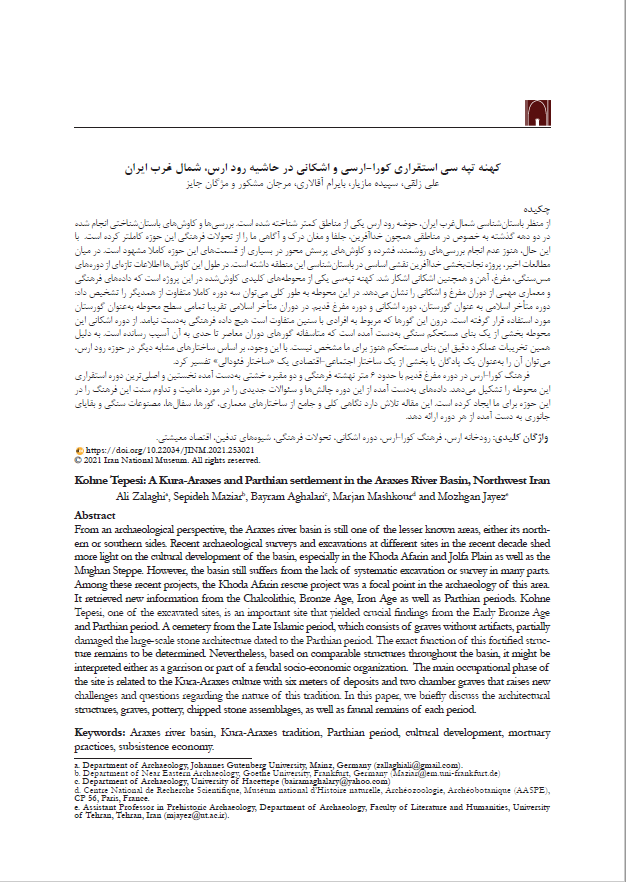 | Zalaghi, Ali; Maziar, Sepideh; Aghalari, Bayram; Mashkour, Marjan; Jayez, Mozhgan: Kohne Tepesi: A Kura-Araxes and Parthian settlement in the Araxes River Basin, Northwest Iran. In: Journal of Iran National Museum, vol. 2, no. 1, 2021. @article{nokey,
title = {Kohne Tepesi: A Kura-Araxes and Parthian settlement in the Araxes River Basin, Northwest Iran},
author = {Ali Zalaghi and Sepideh Maziar and Bayram Aghalari and Marjan Mashkour and Mozhgan Jayez},
doi = {10.22034/JINM.2021.253021},
year = {2021},
date = {2021-01-01},
journal = {Journal of Iran National Museum},
volume = {2},
number = {1},
abstract = {From an archaeological perspective, the Araxes river basin is still one of the lesser known areas, either its northern or southern sides. Recent archaeological surveys and excavations at different sites in the recent decade shed more light on the cultural development of the basin, especially in the Khoda Afarin and Jolfa Plain as well as the Mughan Steppe. However, the basin still suffers from the lack of systematic excavation or survey in many parts. Among these recent projects, the Khoda Afarin rescue project was a focal point in the archaeology of this area. It retrieved new information from the Chalcolithic, Bronze Age, Iron Age as well as Parthian periods. Kohne Tepesi, one of the excavated sites, is an important site that yielded crucial findings from the Early Bronze Age and Parthian period. A cemetery from the Late Islamic period, which consists of graves without artifacts, partially damaged the large-scale stone architecture dated to the Parthian period. The exact function of this fortified structure remains to be determined. Nevertheless, based on comparable structures throughout the basin, it might be interpreted either as a garrison or part of a feudal socioeconomic organization. The main occupational phase of the site is related to the Kura-Araxes culture with six meters of deposits and two chamber graves that raises new challenges and questions regarding the nature of this tradition. In this paper, we briefly discuss the architectural structures, graves, pottery, chipped stone assemblages, as well as faunal remains of each period.},
keywords = {Kura-Araxes, Parthian, Settlement structure},
pubstate = {published},
tppubtype = {article}
}
From an archaeological perspective, the Araxes river basin is still one of the lesser known areas, either its northern or southern sides. Recent archaeological surveys and excavations at different sites in the recent decade shed more light on the cultural development of the basin, especially in the Khoda Afarin and Jolfa Plain as well as the Mughan Steppe. However, the basin still suffers from the lack of systematic excavation or survey in many parts. Among these recent projects, the Khoda Afarin rescue project was a focal point in the archaeology of this area. It retrieved new information from the Chalcolithic, Bronze Age, Iron Age as well as Parthian periods. Kohne Tepesi, one of the excavated sites, is an important site that yielded crucial findings from the Early Bronze Age and Parthian period. A cemetery from the Late Islamic period, which consists of graves without artifacts, partially damaged the large-scale stone architecture dated to the Parthian period. The exact function of this fortified structure remains to be determined. Nevertheless, based on comparable structures throughout the basin, it might be interpreted either as a garrison or part of a feudal socioeconomic organization. The main occupational phase of the site is related to the Kura-Araxes culture with six meters of deposits and two chamber graves that raises new challenges and questions regarding the nature of this tradition. In this paper, we briefly discuss the architectural structures, graves, pottery, chipped stone assemblages, as well as faunal remains of each period. |
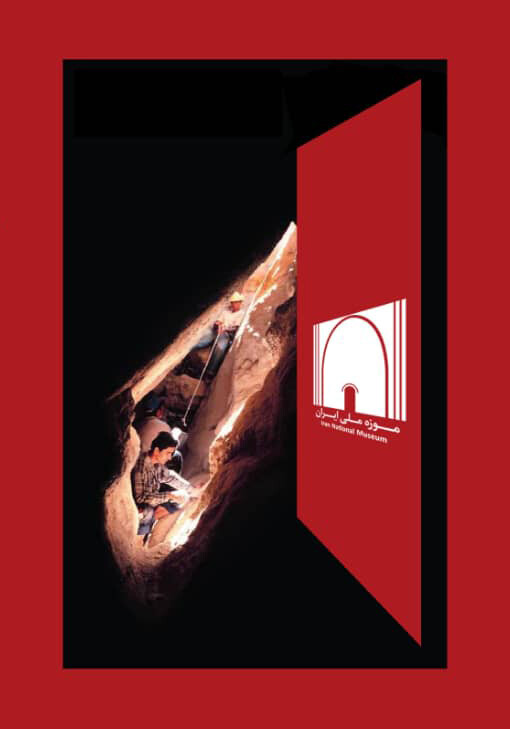 | Stöllner, Thomas; Nokandeh, Jebrael (Ed.): Human Search for Resources. Highlights of Ancient Mining from the German Mining Museum Bochum. 2021. @book{nokey,
title = {Human Search for Resources. Highlights of Ancient Mining from the German Mining Museum Bochum},
editor = {Thomas Stöllner and Jebrael Nokandeh},
url = {https://iranhighlands.com/wp-content/uploads/2022/06/5-3_Human-Search-for-Resources_klein.pdf},
year = {2021},
date = {2021-00-00},
urldate = {2021-00-00},
abstract = {“Human Search for Resources” is a joint exhibition between the German Mining Museum in Bochum and the National Museum of Iran. It seeks to follow the appropriation of humans to mineral resources and the development of the history of human experiences and achievements in mining, which led to the development of technologies, the formation of professions, trade and specialization of industries. More than 200 artefacts from different parts of the world will be shown, such as the findings of the Austrian salt mines or the relief of Linares from Spain, each of which is a valuable symbol of human interaction with natural heritage.},
keywords = {Mining, Resources, Social, social relations, Trade},
pubstate = {published},
tppubtype = {book}
}
“Human Search for Resources” is a joint exhibition between the German Mining Museum in Bochum and the National Museum of Iran. It seeks to follow the appropriation of humans to mineral resources and the development of the history of human experiences and achievements in mining, which led to the development of technologies, the formation of professions, trade and specialization of industries. More than 200 artefacts from different parts of the world will be shown, such as the findings of the Austrian salt mines or the relief of Linares from Spain, each of which is a valuable symbol of human interaction with natural heritage. |
 | Franke, Kristina A.; Kouroshi, Yahya; Skowronek, Miriam; Stöllner, Thomas (Ed.): DFG-SPP 2176: The Iranian Highlands – Resiliences and Integration in Premodern Societies. Accompanying Booklet to the Special Exhibition. 2021. @booklet{nokey,
title = {DFG-SPP 2176: The Iranian Highlands – Resiliences and Integration in Premodern Societies. Accompanying Booklet to the Special Exhibition},
editor = {Kristina A. Franke and Yahya Kouroshi and Miriam Skowronek and Thomas Stöllner},
url = {https://news.rub.de/sites/default/files/spp2176_exhibitbroshuresmall.pdf},
year = {2021},
date = {2021-00-00},
urldate = {2021-00-00},
abstract = {The DFG Priority Programme 2176 “The Iranian Highlands: Resilience and Integration in Premodern Societies” consists of 11 individual projects and a coordination programme. Our common goal is to explore early societies of the Iranian highlands and their resilience strategies. International cooperation of a large number of diff erent institutions in Europe and Iran is the basis for the research endeavour. In addition, there is intensive exchange with the “Patrimonies Project” and the project “Documentation and Historical Dialectology of Lori”, two associated projects that focus on current living conditions, the protection of cultural heritage and the study of dialects in the Iranian highlands.},
month = {00},
keywords = {Administration, Institutions, Integration, Landscape, Mobility, Resilience, Resources},
pubstate = {published},
tppubtype = {booklet}
}
The DFG Priority Programme 2176 “The Iranian Highlands: Resilience and Integration in Premodern Societies” consists of 11 individual projects and a coordination programme. Our common goal is to explore early societies of the Iranian highlands and their resilience strategies. International cooperation of a large number of diff erent institutions in Europe and Iran is the basis for the research endeavour. In addition, there is intensive exchange with the “Patrimonies Project” and the project “Documentation and Historical Dialectology of Lori”, two associated projects that focus on current living conditions, the protection of cultural heritage and the study of dialects in the Iranian highlands. |
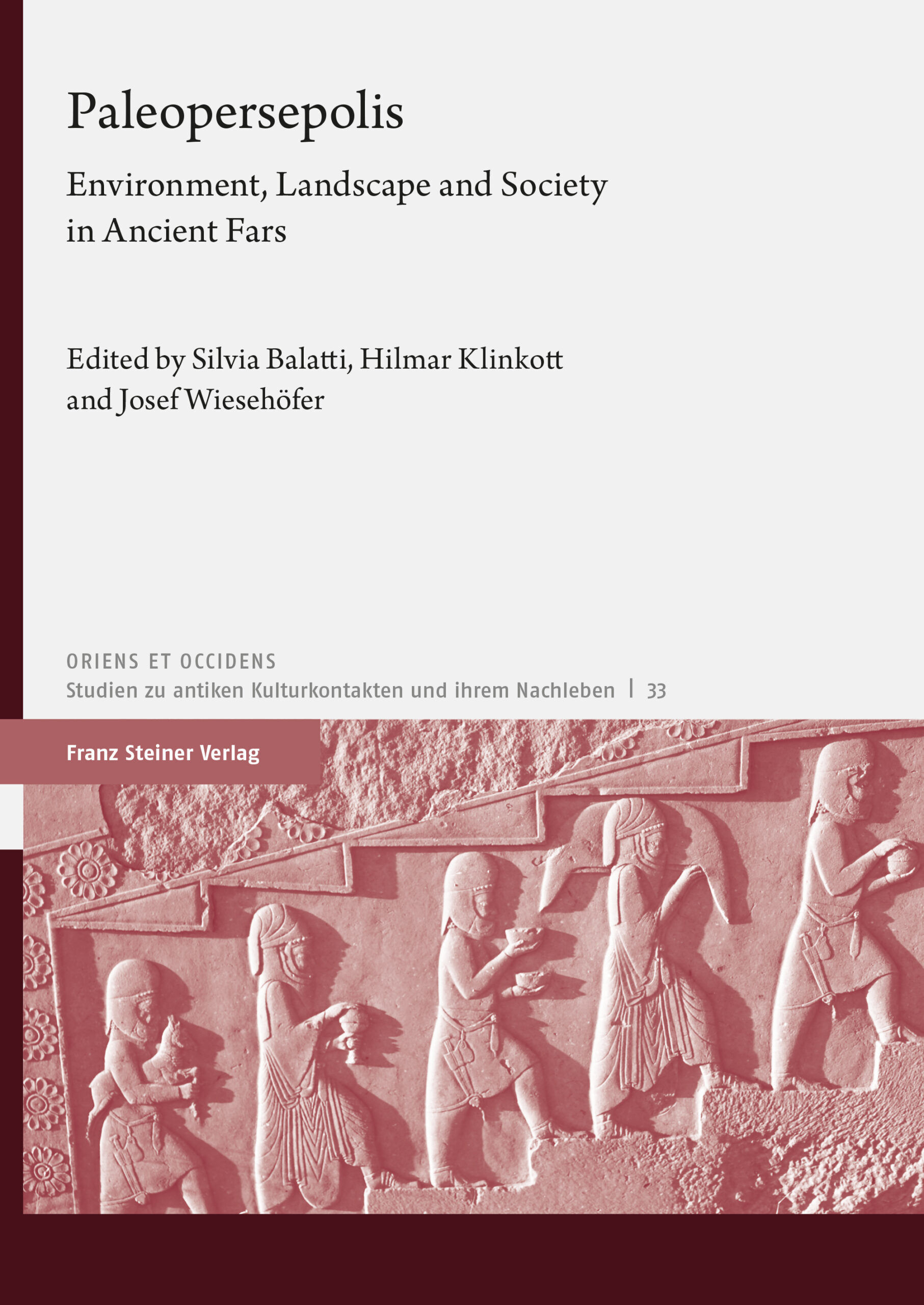 | Henkelman, Wouter F. M.: The Fruits of Pārsa. In: Paleopersepolis: Environment, landscape and society in ancient Fars (Oriens et Occidens), vol. 33, pp. 133-67, 2021. @article{nokey,
title = {The Fruits of Pārsa},
author = {Wouter F.M. Henkelman},
url = {https://www.academia.edu/67513894/The_fruits_of_P%C4%81rsa},
year = {2021},
date = {2021-00-00},
urldate = {2021-00-00},
journal = {Paleopersepolis: Environment, landscape and society in ancient Fars (Oriens et Occidens)},
volume = {33},
pages = {133-67},
keywords = {Environmental conditions, Landscape, Social, social relations},
pubstate = {published},
tppubtype = {article}
}
|
 | Djamali, Morteza; Rashidian, Elnaz; Askari-Chaverdi, Alireza; Aubert, Cyril; Brisset, Elodie; Demory, François; Faucherre, Nicolas; Gandouin, Emmanuel; Lahijani, Hamid; Marriner, Nick; Naderi-Beni, Abdolmajid; Parnell, Andrew: Early Sasanian Landscape Modification: New Geoarchaeological Evidence From the Ardashir Pond in Southwest Iran (Palace of Ardashir, Third Century CE). In: Geoarchaeology, iss. 36, pp. 925–42, 2021. @article{nokey,
title = {Early Sasanian Landscape Modification: New Geoarchaeological Evidence From the Ardashir Pond in Southwest Iran (Palace of Ardashir, Third Century CE)},
author = {Morteza Djamali and Elnaz Rashidian and Alireza Askari-Chaverdi and Cyril Aubert and Elodie Brisset and François Demory and Nicolas Faucherre and Emmanuel Gandouin and Hamid Lahijani and Nick Marriner and Abdolmajid Naderi-Beni and Andrew Parnell},
doi = {https://doi.org/10.1002/gea.21880},
year = {2021},
date = {2021-00-00},
urldate = {2021-00-00},
journal = {Geoarchaeology},
issue = {36},
pages = {925–42},
abstract = {The Sasanian period (224–651 CE) marked an era of large-scale urban projects in southwest Asia, including Iran's semi-arid highlands, with particular efforts to manipulate water bodies. This study presents a recent interdisciplinary investigation of a spring-fed pond at the entrance of the Palace of Ardashir (Firuzabad plain, southwest Iran), part of a recently registered World Heritage site. Historical accounts suggest that the entire water system of the plain, including the pond, underwent a hydraulic re-organization at the beginning of the Sasanian period, a fact that has never been investigated geoarchaeologically. A series of sediment cores were retrieved from the pond to probe its evolution and examine the extent of its landscape modification. The cores were sedimentologically described and radiocarbon-dated with age–depth models established based on 57 AMS (accelerator mass spectrometry) 14C dates to understand the basin's depositional history. The results indicate that (i) Ardashir Pond has existed as part of a larger wetland complex since at least 4500 years ago, (ii) it was substantially enlarged at the beginning of the Sasanian era, and (iii) it was abandoned at the end of the Sasanian period. The Ardashir Pond is one of the first geoarchaeologically investigated case studies to demonstrate the Sasanian landscape in the framework of the “Iranshahr” sociopolitical concept.},
keywords = {Fars, Landscape, Sasanian},
pubstate = {published},
tppubtype = {article}
}
The Sasanian period (224–651 CE) marked an era of large-scale urban projects in southwest Asia, including Iran's semi-arid highlands, with particular efforts to manipulate water bodies. This study presents a recent interdisciplinary investigation of a spring-fed pond at the entrance of the Palace of Ardashir (Firuzabad plain, southwest Iran), part of a recently registered World Heritage site. Historical accounts suggest that the entire water system of the plain, including the pond, underwent a hydraulic re-organization at the beginning of the Sasanian period, a fact that has never been investigated geoarchaeologically. A series of sediment cores were retrieved from the pond to probe its evolution and examine the extent of its landscape modification. The cores were sedimentologically described and radiocarbon-dated with age–depth models established based on 57 AMS (accelerator mass spectrometry) 14C dates to understand the basin's depositional history. The results indicate that (i) Ardashir Pond has existed as part of a larger wetland complex since at least 4500 years ago, (ii) it was substantially enlarged at the beginning of the Sasanian era, and (iii) it was abandoned at the end of the Sasanian period. The Ardashir Pond is one of the first geoarchaeologically investigated case studies to demonstrate the Sasanian landscape in the framework of the “Iranshahr” sociopolitical concept. |
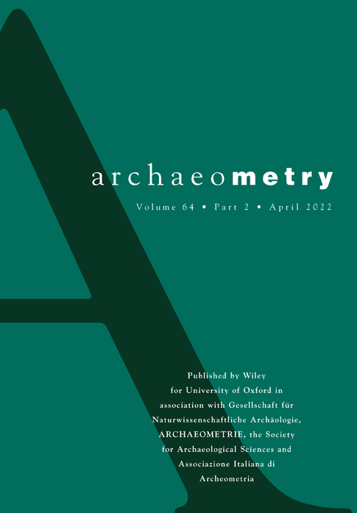 | Djamali, Morteza; Rashidian, Elnaz; Capano, Manuela; Askari-Chaverdi, Alireza; Faucherre, Nicolas; Guibal, Frédéric; Northedge, Alastair; Tuna, Thibaut; Bard, Edouard: An Absolute Radiocarbon Chronology for the World Heritage Site of Sarvestan (SW Iran): A Late Sasanian Heritage in Early Islamic Era. In: Archaeometry, iss. 64, no. 2, pp. 545–59, 2021. @article{nokey,
title = {An Absolute Radiocarbon Chronology for the World Heritage Site of Sarvestan (SW Iran): A Late Sasanian Heritage in Early Islamic Era},
author = {Morteza Djamali and Elnaz Rashidian and Manuela Capano and Alireza Askari-Chaverdi and Nicolas Faucherre and Frédéric Guibal and Alastair Northedge and Thibaut Tuna and Edouard Bard},
doi = {https://doi.org/10.1111/arcm.12716},
year = {2021},
date = {2021-00-00},
urldate = {2021-00-00},
journal = {Archaeometry},
number = {2},
issue = {64},
pages = {545–59},
abstract = {This study presents a new precise radiocarbon chronology for the World Heritage site of Sarvestan (SW Iran). The monument is a key construction in the history of architecture because it is a typical Sasanian construction built during the late Sasanian or early Islamic period. Previous attempts to date the monument have suggested the ages ranging from the middle Sasanian (fifth century CE) to early Abbasid (ninth century CE) era. These age estimations are based on the analysis of architectural plans and techniques, and a few radiocarbon dates with very large age uncertainties. This paper presents the results of a systematic radiocarbon dating of timbers in the walls and charcoals in plaster mortars used in the main dome of the monument. It further applies wiggle matching technique and R_Combine function to substantially reduce the age uncertainties in wood sections. The results indicate that a major construction work was undertaken sometime between 658 and 683 CE, the century of the invasion of Fars by Muslim Arabs. This finding pushes back the age of Sarvestan for two centuries and suggests that the monument was built at the transitional period between Sasanian to Islamic era. Sarvestan would have been an architectural project designed and possibly initiated during the late Sasanian period but mainly accomplished during the second half of the seventh century CE. It can thus be considered a late Sasanian heritage in early Islamic period. Its construction at a time of political unrest further suggests that some areas of Fars may have benefited from certain socio-political stabilities during the expansion of Islam into the east at mid- to late seventh century CE.},
keywords = {Dating, Islamic era, Sasanian},
pubstate = {published},
tppubtype = {article}
}
This study presents a new precise radiocarbon chronology for the World Heritage site of Sarvestan (SW Iran). The monument is a key construction in the history of architecture because it is a typical Sasanian construction built during the late Sasanian or early Islamic period. Previous attempts to date the monument have suggested the ages ranging from the middle Sasanian (fifth century CE) to early Abbasid (ninth century CE) era. These age estimations are based on the analysis of architectural plans and techniques, and a few radiocarbon dates with very large age uncertainties. This paper presents the results of a systematic radiocarbon dating of timbers in the walls and charcoals in plaster mortars used in the main dome of the monument. It further applies wiggle matching technique and R_Combine function to substantially reduce the age uncertainties in wood sections. The results indicate that a major construction work was undertaken sometime between 658 and 683 CE, the century of the invasion of Fars by Muslim Arabs. This finding pushes back the age of Sarvestan for two centuries and suggests that the monument was built at the transitional period between Sasanian to Islamic era. Sarvestan would have been an architectural project designed and possibly initiated during the late Sasanian period but mainly accomplished during the second half of the seventh century CE. It can thus be considered a late Sasanian heritage in early Islamic period. Its construction at a time of political unrest further suggests that some areas of Fars may have benefited from certain socio-political stabilities during the expansion of Islam into the east at mid- to late seventh century CE. |
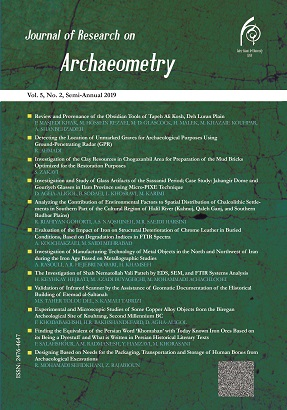 | Hariri, Nemat; Rezalo, Reza; Zadeh, Ardeshir Javanmard; Heydari-Guran, Saman: Correlation of the Epipaleolithic Period in the West-Central Zagros and North Zagros with Climatic Events after the Last Glacial Maximum (LGM). In: Journal of Research on Archaeometry, iss. 7, no. 1, pp. 205-29, 2021. @article{nokey,
title = {Correlation of the Epipaleolithic Period in the West-Central Zagros and North Zagros with Climatic Events after the Last Glacial Maximum (LGM)},
author = {Nemat Hariri and Reza Rezalo and Ardeshir Javanmard Zadeh and Saman Heydari-Guran},
doi = {https://doi.org/10.52547/jra.7.1.205},
year = {2021},
date = {2021-00-00},
urldate = {2021-00-00},
journal = {Journal of Research on Archaeometry},
number = {1},
issue = {7},
pages = {205-29},
abstract = {Up to now, two areas of northern and west-central Zagros Mountains (ZM) have produced better information concerning the development of techno-typology of lithic artefacts during the Epipaleolithic period (EP) compare to the other part of this region. Although several caves and rockshelters associated with EP deposits are found in this region (Map 1), but they were not subject to study for the relationship between climate effect on cultural developments like the neighbored area of Levant. this deficiency can be attributed to a) the low number of excavated sites, b) poor stratigraphic control, and c) the lack of a sufficient number of absolute dates. Recent absolute date achievements from the EP site of Palegawra cave [17]. locates on the northern ZM alongside Paleoclimatic reconstruction in Hashilan wetland [8] based on the palynological studies have improved our understanding from Epipaleolthic cultural and environmental events for the region.},
keywords = {Palaeolithic, Zagros},
pubstate = {published},
tppubtype = {article}
}
Up to now, two areas of northern and west-central Zagros Mountains (ZM) have produced better information concerning the development of techno-typology of lithic artefacts during the Epipaleolithic period (EP) compare to the other part of this region. Although several caves and rockshelters associated with EP deposits are found in this region (Map 1), but they were not subject to study for the relationship between climate effect on cultural developments like the neighbored area of Levant. this deficiency can be attributed to a) the low number of excavated sites, b) poor stratigraphic control, and c) the lack of a sufficient number of absolute dates. Recent absolute date achievements from the EP site of Palegawra cave [17]. locates on the northern ZM alongside Paleoclimatic reconstruction in Hashilan wetland [8] based on the palynological studies have improved our understanding from Epipaleolthic cultural and environmental events for the region. |
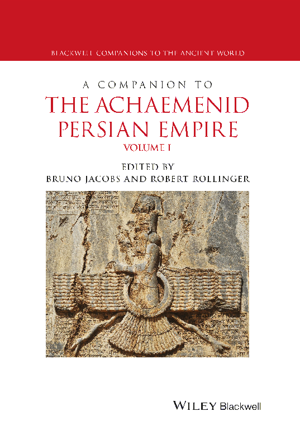 | Henkelman, Wouter F. M.: Local Administration: Persia. In: A companion to the Achaemenid Persian Empire, vol. 2, pp. 881—904, John Wiley & Sons, 2021. @inbook{nokey,
title = {Local Administration: Persia},
author = {Wouter F.M. Henkelman},
url = {https://www.academia.edu/41141153/Local_Administration_Persia},
year = {2021},
date = {2021-00-00},
urldate = {2021-00-00},
booktitle = {A companion to the Achaemenid Persian Empire},
volume = {2},
pages = {881—904},
publisher = {John Wiley & Sons},
series = {A companion to the Achaemenid Persian Empire 2},
abstract = {Two predominantly Elamite archives found at Persepolis are the prime source for the local administration of the Achaemenid heartland per se as well as for the backbone for any socioeconomic history of the empire at large. The sur- vey offered here centers on administrative structures, hierarchies, and proto-cols in relation with other textual sources; it is supplemented by another survey (Henkelman 2013b), focusing on find circumstances, formal charac-teristics, and connections with archeological discoveries (other surveys: Cahill 1985; Briant 2002: pp. 422–471; Henkelman 2008b: pp. 65–179, 2013a; Azzoni et al. 2017; Garrison 2017: pp. 15–116; cf. Kuhrt 2007: pp. 763–825).
},
keywords = {Achaemenid, Administration, Clay tablets, Elam, Institutions, Textual sources},
pubstate = {published},
tppubtype = {inbook}
}
Two predominantly Elamite archives found at Persepolis are the prime source for the local administration of the Achaemenid heartland per se as well as for the backbone for any socioeconomic history of the empire at large. The sur- vey offered here centers on administrative structures, hierarchies, and proto-cols in relation with other textual sources; it is supplemented by another survey (Henkelman 2013b), focusing on find circumstances, formal charac-teristics, and connections with archeological discoveries (other surveys: Cahill 1985; Briant 2002: pp. 422–471; Henkelman 2008b: pp. 65–179, 2013a; Azzoni et al. 2017; Garrison 2017: pp. 15–116; cf. Kuhrt 2007: pp. 763–825).
|
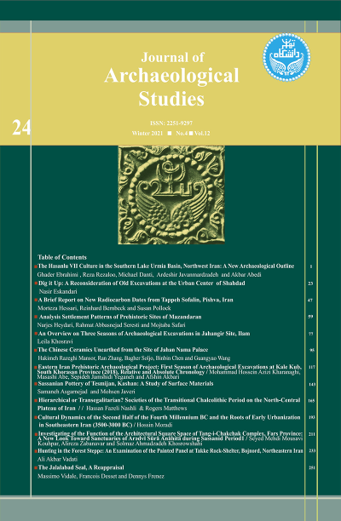 | Hessari, Morteza; Bernbeck, Reinhard; Pollock, Susan: A Brief Report on New Radiocarbon Dates from Tappeh Sofalin, Pishva, Iran. In: Iranian Journal of Archaeological Studies, iss. 12, no. 4, pp. 49-61, 2021. @article{nokey,
title = {A Brief Report on New Radiocarbon Dates from Tappeh Sofalin, Pishva, Iran},
author = {Morteza Hessari and Reinhard Bernbeck and Susan Pollock},
doi = {https://doi.org/10.22059/jarcs.2021.306385.142902},
year = {2021},
date = {2021-00-00},
urldate = {2021-00-00},
journal = {Iranian Journal of Archaeological Studies},
number = {4},
issue = {12},
pages = {49-61},
abstract = {In the summer of 2017, renewed fieldwork was undertaken at Tappeh Sofalin in the Varamin Plain. A total of 20 samples for absolute dating were collected during this season, several of which have been analyzed. We present this new evidence for the dating of the site and compare it briefly with published dates and analyses from other sites. Finally, we discuss implications for the chronology of the Proto-Elamite spread to the Central Plateau and other areas of Iran.},
keywords = {Chronology, Dating, Elam, Tehran},
pubstate = {published},
tppubtype = {article}
}
In the summer of 2017, renewed fieldwork was undertaken at Tappeh Sofalin in the Varamin Plain. A total of 20 samples for absolute dating were collected during this season, several of which have been analyzed. We present this new evidence for the dating of the site and compare it briefly with published dates and analyses from other sites. Finally, we discuss implications for the chronology of the Proto-Elamite spread to the Central Plateau and other areas of Iran. |
 | Heydari-Guran, Saman; Douka, Katerina; Higham, Thomas; Münzel, Susanne C.; Deckers, Katleen; Hourshid, Shaghayegh; Naderi, Rahmat; Asiabani, Samran; Ghasidian, Elham: Early Upper Palaeolithic Occupation at Gelimgoush Cave, Kermanshah; West-Central Zagros Mountains of Iran. In: Journal of Archaeological Science: Reports, iss. 38, 2021. @article{nokey,
title = {Early Upper Palaeolithic Occupation at Gelimgoush Cave, Kermanshah; West-Central Zagros Mountains of Iran},
author = {Saman Heydari-Guran and Katerina Douka and Thomas Higham and Susanne C. Münzel and Katleen Deckers and Shaghayegh Hourshid and Rahmat Naderi and Samran Asiabani and Elham Ghasidian},
doi = {http://dx.doi.org/10.1016/j.jasrep.2021.103050},
year = {2021},
date = {2021-00-00},
urldate = {2021-00-00},
journal = {Journal of Archaeological Science: Reports},
issue = {38},
abstract = {The timing and dispersal routes of Homo sapiens (H. sapiens) into the Iranian Plateau have always been a matter of debate in the recent years. Current studies on the Upper Palaeolithic period of the Zagros mountains demonstrated the later colonisation of West-Central Zagros by H. sapiens based on techno-typological and radiocarbon dating. The Kermanshah region is one of the main concentrations of Palaeolithic sites in the West-Central Zagros mountains. Despite presenting rich Palaeolithic sequence records, it suffers from the lack of stratified data associated with chronological control. This issue, until now, has prevented us from evaluating and knowing how these archaeological records relate to the patterns of H. sapiens dispersal and colonisation into the West-Central Zagros mountains. Here, we present the first excavated and dated Palaeolithic site in Kermanshah. Eshkaft-e Gelimgoush Cave yielded a classic Upper Palaeolithic assemblage, representing the Lorestan and Kermanshah (LaK) cultural group documented in the West-Central Zagros. Radiocarbon dates, associated with the material culture from this cave, provide the first dated stratified Upper Palaeolithic evidence in Kermanshah. The data from Eshkaft-e Gelimgoush are consistent with the cultural diversity model among the Upper Palaeolithic populations in the Zagros and confirm later colonisation of the West-Central than northern and southern Zagros mountains.},
keywords = {Kermanshah, Palaeolithic, Zagros},
pubstate = {published},
tppubtype = {article}
}
The timing and dispersal routes of Homo sapiens (H. sapiens) into the Iranian Plateau have always been a matter of debate in the recent years. Current studies on the Upper Palaeolithic period of the Zagros mountains demonstrated the later colonisation of West-Central Zagros by H. sapiens based on techno-typological and radiocarbon dating. The Kermanshah region is one of the main concentrations of Palaeolithic sites in the West-Central Zagros mountains. Despite presenting rich Palaeolithic sequence records, it suffers from the lack of stratified data associated with chronological control. This issue, until now, has prevented us from evaluating and knowing how these archaeological records relate to the patterns of H. sapiens dispersal and colonisation into the West-Central Zagros mountains. Here, we present the first excavated and dated Palaeolithic site in Kermanshah. Eshkaft-e Gelimgoush Cave yielded a classic Upper Palaeolithic assemblage, representing the Lorestan and Kermanshah (LaK) cultural group documented in the West-Central Zagros. Radiocarbon dates, associated with the material culture from this cave, provide the first dated stratified Upper Palaeolithic evidence in Kermanshah. The data from Eshkaft-e Gelimgoush are consistent with the cultural diversity model among the Upper Palaeolithic populations in the Zagros and confirm later colonisation of the West-Central than northern and southern Zagros mountains. |
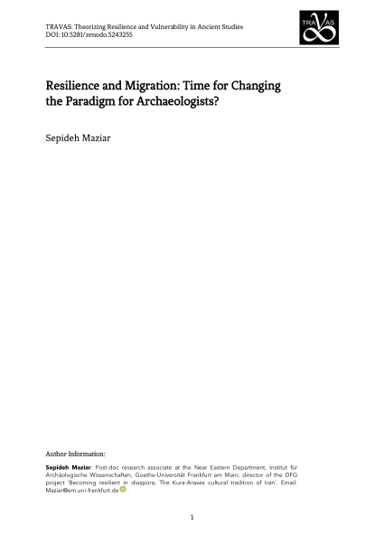 | Maziar, Sepideh: Resilience and Migration: Time for Changing the Paradigm for Archaeologists?. 2021, visited: 30.11.2020. @online{nokey,
title = {Resilience and Migration: Time for Changing the Paradigm for Archaeologists?},
author = {Sepideh Maziar},
doi = {http://dx.doi.org/10.5281/zenodo.5093035},
year = {2021},
date = {2021-00-00},
urldate = {2021-00-00},
booktitle = {TRAVAS: Theorizing Resilience and Vulnerability in Ancient Studies},
journal = {Archaeological Report Monograph Series },
number = {7},
abstract = {In the social sciences, there are different narratives of migration. In archaeology, however, this theme is conventionally tackled in many cases from within an old-fashioned traditional framework. Accordingly, some scholars consider it a mono-factorial approach that overlooks the complexity and diversity of other factors at play. Others ignore it, not wishing to be regarded as anachronistic scholars or as being trapped in culture-historical or diffusionist paradigms. In this short essay, I discuss migration in the context of social resilience by adopting approaches from human geography, such as translocality. I argue that this approach will be more promising in the context of migration in anthropological archaeology.},
keywords = {Mobility, Resilience},
pubstate = {published},
tppubtype = {online}
}
In the social sciences, there are different narratives of migration. In archaeology, however, this theme is conventionally tackled in many cases from within an old-fashioned traditional framework. Accordingly, some scholars consider it a mono-factorial approach that overlooks the complexity and diversity of other factors at play. Others ignore it, not wishing to be regarded as anachronistic scholars or as being trapped in culture-historical or diffusionist paradigms. In this short essay, I discuss migration in the context of social resilience by adopting approaches from human geography, such as translocality. I argue that this approach will be more promising in the context of migration in anthropological archaeology. |
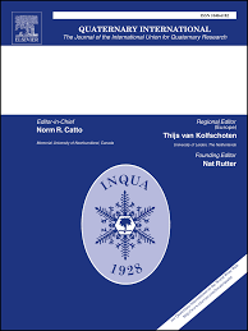 | Maziar, Sepideh: Geographical Proximity and Material Culture; The Interplay Between Syunik and the Southern Part of the Araxes River Basin in the 6th to the 3rd Millennium BC. In: Quaternary International, iss. 579, pp. 42-58, 2021. @article{nokey,
title = {Geographical Proximity and Material Culture; The Interplay Between Syunik and the Southern Part of the Araxes River Basin in the 6th to the 3rd Millennium BC},
author = {Sepideh Maziar},
doi = {https://doi.org/10.1016/j.quaint.2020.03.055},
year = {2021},
date = {2021-00-00},
urldate = {2021-00-00},
journal = {Quaternary International},
issue = {579},
pages = {42-58},
abstract = {The region that is known today as Syunik in the south/southeastern part of Armenia is geographically a close neighbour of the southern part of the Araxes river basin in today Iran. Political upheavals and boundaries hindered fieldwork in these areas for many years. The archaeological project of the Araxes valley (APAV) is one of many other projects that launched in 2013 in this region and focused on the southern basin of the Araxes River. The results of the excavations of two sites, Kohne Pasgah Tepesi and Kohne Tepesi, and the intensive survey carried out in this area, enable us to shed more light on the settlement dynamics, material culture and economic/social networks of this area and its neighbours.
The period from the 6th up to the middle part of the 4th millennium BC represents the Neolithic and Chalcolithic periods in this region. The material culture of both periods shares many common characteristics with contemporary traditions at sites of the southern Caucasus. Later, in the last part of the 4th millennium BC, a cultural tradition that originated in the southern Caucasus, known as the Kura-Araxes cultural tradition, expanded over a vast area, including the southern part of the Araxes river basin. Based on the study of the pottery styles and obsidian flow, the patterns of interconnection between regions, communities, and sources, and commodity flows are examined. The role of the Araxes River and its tributaries in this interplay over the stated time span is the other inquiry of this article. Furthermore, I will investigate whether spatial propinquity had any impact on commodity flows and exchange, and if so, did this impact affected the material culture and technological practices or not.},
keywords = {Bronze Age, Chalcolithic, Economy, Kura-Araxes, Neolithic, Settlement mobility, Social, social relations, Survey},
pubstate = {published},
tppubtype = {article}
}
The region that is known today as Syunik in the south/southeastern part of Armenia is geographically a close neighbour of the southern part of the Araxes river basin in today Iran. Political upheavals and boundaries hindered fieldwork in these areas for many years. The archaeological project of the Araxes valley (APAV) is one of many other projects that launched in 2013 in this region and focused on the southern basin of the Araxes River. The results of the excavations of two sites, Kohne Pasgah Tepesi and Kohne Tepesi, and the intensive survey carried out in this area, enable us to shed more light on the settlement dynamics, material culture and economic/social networks of this area and its neighbours.
The period from the 6th up to the middle part of the 4th millennium BC represents the Neolithic and Chalcolithic periods in this region. The material culture of both periods shares many common characteristics with contemporary traditions at sites of the southern Caucasus. Later, in the last part of the 4th millennium BC, a cultural tradition that originated in the southern Caucasus, known as the Kura-Araxes cultural tradition, expanded over a vast area, including the southern part of the Araxes river basin. Based on the study of the pottery styles and obsidian flow, the patterns of interconnection between regions, communities, and sources, and commodity flows are examined. The role of the Araxes River and its tributaries in this interplay over the stated time span is the other inquiry of this article. Furthermore, I will investigate whether spatial propinquity had any impact on commodity flows and exchange, and if so, did this impact affected the material culture and technological practices or not. |
 | Öhrström, Lena Maria; Marquez, Herman; Seiler, Roger; Bode, Beata; Aali, Abolfazl; Stöllner, Thomas; Rühli, Frank Jakobus: Radiological and Histological Findings in Ancient Salt Mummies From the Salt Mine of DouzlāKh, Iran. In: PLoS ONE, iss. 16, no. 4, 2021. @article{nokey,
title = {Radiological and Histological Findings in Ancient Salt Mummies From the Salt Mine of DouzlāKh, Iran},
author = {Lena Maria Öhrström and Herman Marquez and Roger Seiler and Beata Bode and Abolfazl Aali and Thomas Stöllner and Frank Jakobus Rühli},
doi = {https://doi.org/10.1371/journal.pone.0250745},
year = {2021},
date = {2021-00-00},
urldate = {2021-00-00},
journal = {PLoS ONE},
number = {4},
issue = {16},
abstract = {Computed tomography studies and histological analyses were performed on the mummified remains found in the Chehrābād salt mine in northwestern Iran. The ancient salt mummies are dated to the Achaemenid (550–330 BC) and Sassanid (3rd–7th century AD) time period and died in mining incidents. The aim of the study was to describe the radiological and histological findings of several ancient Iranian salt mummies with special interest in pathological and postmortem changes. The mummified remains show multiple traumatic alterations, such as fractures and signs of massive compression. Histological analyses can clearly differentiate soft tissue, however the preservation status is variable. These Iranian salt mummies are a rare example of the ancient Iranian population. The soft tissue and organs are well preserved, however in different degrees due to the varying conditions.},
keywords = {Archaeobotany, Mining, Zanjan},
pubstate = {published},
tppubtype = {article}
}
Computed tomography studies and histological analyses were performed on the mummified remains found in the Chehrābād salt mine in northwestern Iran. The ancient salt mummies are dated to the Achaemenid (550–330 BC) and Sassanid (3rd–7th century AD) time period and died in mining incidents. The aim of the study was to describe the radiological and histological findings of several ancient Iranian salt mummies with special interest in pathological and postmortem changes. The mummified remains show multiple traumatic alterations, such as fractures and signs of massive compression. Histological analyses can clearly differentiate soft tissue, however the preservation status is variable. These Iranian salt mummies are a rare example of the ancient Iranian population. The soft tissue and organs are well preserved, however in different degrees due to the varying conditions. |
 | Rossi, Conor; Ruß-Popa, Gabriela; Mattiangeli, Valeria; McDaid, Fionnuala; Hare, Andrew J.; Davoudi, Hossein; Laleh, Haeedeh; Lorzadeh, Zahra; Khazaeli, Roya; Fathi, Homa; Teasdale, Matthew D.; Aali, Abolfazl; Stöllner, Thomas; Mashkour, Marjan; Daly, Kevin G.: Exceptional Ancient DNA Preservation and Fibre Remains of a Sasanian Saltmine Sheep Mummy in ChehrāBāD, Iran. In: Biological letters, iss. 17, 2021. @article{nokey,
title = {Exceptional Ancient DNA Preservation and Fibre Remains of a Sasanian Saltmine Sheep Mummy in ChehrāBāD, Iran},
author = {Conor Rossi and Gabriela Ruß-Popa and Valeria Mattiangeli and Fionnuala McDaid and Andrew J. Hare and Hossein Davoudi and Haeedeh Laleh and Zahra Lorzadeh and Roya Khazaeli and Homa Fathi and Matthew D. Teasdale and Abolfazl Aali and Thomas Stöllner and Marjan Mashkour and Kevin G. Daly},
doi = {https://doi.org/10.1098/rsbl.2021.0222},
year = {2021},
date = {2021-00-00},
urldate = {2021-00-00},
journal = {Biological letters},
issue = {17},
abstract = {Mummified remains have long attracted interest as a potential source of ancient DNA. However, mummification is a rare process that requires an anhydrous environment to rapidly dehydrate and preserve tissue before complete decomposition occurs. We present the whole-genome sequences (3.94 X) of an approximately 1600-year-old naturally mummified sheep recovered from Chehrābād, a salt mine in northwestern Iran. Comparative analyses of published ancient sequences revealed the remarkable DNA integrity of this mummy. Hallmarks of postmortem damage, fragmentation and hydrolytic deamination are substantially reduced, likely owing to the high salinity of this taphonomic environment. Metagenomic analyses reflect the profound influence of high-salt content on decomposition; its microbial profile is predominated by halophilic archaea and bacteria, possibly contributing to the remarkable preservation of the sample. Applying population genomic analyses, we find clustering of this sheep with Southwest Asian modern breeds, suggesting ancestry continuity. Genotyping of a locus influencing the woolly phenotype showed the presence of an ancestral ‘hairy’ allele, consistent with hair fibre imaging. This, along with derived alleles associated with the fat-tail phenotype, provides genetic evidence that Sasanian-period Iranians maintained specialized sheep flocks for different uses, with the ‘hairy’, ‘fat-tailed’-genotyped sheep likely kept by the rural community of Chehrābād's miners.},
keywords = {Archaeozoology, Salt, Zanjan},
pubstate = {published},
tppubtype = {article}
}
Mummified remains have long attracted interest as a potential source of ancient DNA. However, mummification is a rare process that requires an anhydrous environment to rapidly dehydrate and preserve tissue before complete decomposition occurs. We present the whole-genome sequences (3.94 X) of an approximately 1600-year-old naturally mummified sheep recovered from Chehrābād, a salt mine in northwestern Iran. Comparative analyses of published ancient sequences revealed the remarkable DNA integrity of this mummy. Hallmarks of postmortem damage, fragmentation and hydrolytic deamination are substantially reduced, likely owing to the high salinity of this taphonomic environment. Metagenomic analyses reflect the profound influence of high-salt content on decomposition; its microbial profile is predominated by halophilic archaea and bacteria, possibly contributing to the remarkable preservation of the sample. Applying population genomic analyses, we find clustering of this sheep with Southwest Asian modern breeds, suggesting ancestry continuity. Genotyping of a locus influencing the woolly phenotype showed the presence of an ancestral ‘hairy’ allele, consistent with hair fibre imaging. This, along with derived alleles associated with the fat-tail phenotype, provides genetic evidence that Sasanian-period Iranians maintained specialized sheep flocks for different uses, with the ‘hairy’, ‘fat-tailed’-genotyped sheep likely kept by the rural community of Chehrābād's miners. |
 | Stöllner, Thomas; Aali, Abolfazl: Einblicke in eine Katastrophe. Das Salzbergwerk von Douzlākh bei Chehrābād. In: Karlsruhe, Badisches Landesmuseum (Ed.): vol. Die Perser. Am Hof der Großkönige, pp. 116-20, WBG/Philipp von Zabern, Darmstadt, 2021, ISBN: ISBN 978-3-8053-5276-5. @inbook{nokey,
title = {Einblicke in eine Katastrophe. Das Salzbergwerk von Douzlākh bei Chehrābād},
author = {Thomas Stöllner and Abolfazl Aali},
editor = {Badisches Landesmuseum Karlsruhe},
url = {https://www.wbg-wissenverbindet.de/shop/35056/die-perser},
isbn = {ISBN 978-3-8053-5276-5},
year = {2021},
date = {2021-00-00},
urldate = {2021-00-00},
volume = {Die Perser. Am Hof der Großkönige},
pages = {116-20},
publisher = {WBG/Philipp von Zabern},
address = {Darmstadt},
keywords = {Achaemenid, Administration, Institutions, Mining, Salt, Sasanian, Zanjan},
pubstate = {published},
tppubtype = {inbook}
}
|
 | Henkelman, Wouter F. M.; Jacobs, Bruno: Roads and Communication. In: A companion to the Achaemenid Persian Empire 1, vol. 1, pp. 219-735, John Wiley & Sons, Hoboken, 2021. @inbook{nokey,
title = {Roads and Communication},
author = {Wouter F.M. Henkelman and Bruno Jacobs},
doi = {https://doi.org/10.1002/9781119071860.ch53},
year = {2021},
date = {2021-00-00},
urldate = {2021-00-00},
booktitle = {A companion to the Achaemenid Persian Empire 1},
volume = {1},
issue = {1},
pages = {219-735},
publisher = {John Wiley & Sons},
address = {Hoboken},
series = {A Companion to the Achaemenid Persian Empire},
abstract = {A refined and extensive net of roads ran through the Achaemenid Empire, known as “royal roads” in the classical sources. They served messengers and embassies as well as being used for the transport of taxes and tributes. Because of their considerable width, they were suited for the movement of troops and transport by larger vehicles. Roads such as the well-documented connections between Sardis and Susa or between Persepolis and Susa crossed and opened up the entire empire. There were also countless auxiliary roads. Furthermore, travel and transport by water played an important role.
The transport network guaranteed a speedy flow of information and empire-wide communication, and thus provisioning for travelers was secured, way stations were maintained, and a high standard of safety was guaranteed.},
keywords = {Achaemenid, Administration, Institutions, Structure development},
pubstate = {published},
tppubtype = {inbook}
}
A refined and extensive net of roads ran through the Achaemenid Empire, known as “royal roads” in the classical sources. They served messengers and embassies as well as being used for the transport of taxes and tributes. Because of their considerable width, they were suited for the movement of troops and transport by larger vehicles. Roads such as the well-documented connections between Sardis and Susa or between Persepolis and Susa crossed and opened up the entire empire. There were also countless auxiliary roads. Furthermore, travel and transport by water played an important role.
The transport network guaranteed a speedy flow of information and empire-wide communication, and thus provisioning for travelers was secured, way stations were maintained, and a high standard of safety was guaranteed. |
 | Henkelman, Wouter F. M.; Stolper, Matthew W.: Counting Trees around Persepolis. In: Agut-Labordère, Damien; Boucharlat, Rémy; Joannès, Francis; Kuhrt, Amélie; Stolper, Matthew W. (Ed.): Achemenet, vingt ans après: Études offertes à Pierre Briant à l’occasion des vingt ans du Programme Achemenet , pp. 169-199, Peeters, Leuven, 2021. @inbook{nokey,
title = {Counting Trees around Persepolis},
author = {Wouter F.M. Henkelman and Matthew W. Stolper},
editor = {Damien Agut-Labordère and Rémy Boucharlat and Francis Joannès and Amélie Kuhrt and Matthew W. Stolper},
doi = {https://doi.org/10.2307/j.ctv1q26jhj},
year = {2021},
date = {2021-00-00},
urldate = {2021-00-00},
booktitle = {Achemenet, vingt ans après: Études offertes à Pierre Briant à l’occasion des vingt ans du Programme Achemenet },
pages = {169-199},
publisher = {Peeters},
address = {Leuven},
series = {Persika 21},
keywords = {Achaemenid, Fars},
pubstate = {published},
tppubtype = {inbook}
}
|
 | Heydari-Guran, Saman; Ghasidian, Elham: Consistency of the ‘MIS 5 Humid Corridor Model’ for the Dispersal of Early Homo Sapiens into the Iranian Plateau. In: Autor*innenkollektiv, (Ed.): Pearls, Politics and Pistachios: Essays in Anthropology and Memories on the Occasion of Susan Pollock’s 65th Birthday, pp. 219-237, Propyleum, Heidelberg, 2021. @inbook{nokey,
title = {Consistency of the ‘MIS 5 Humid Corridor Model’ for the Dispersal of Early Homo Sapiens into the Iranian Plateau},
author = {Saman Heydari-Guran and Elham Ghasidian},
editor = {Autor*innenkollektiv},
doi = {https://doi.org/10.11588/propylaeum.837.c10746},
year = {2021},
date = {2021-00-00},
urldate = {2021-00-00},
booktitle = {Pearls, Politics and Pistachios: Essays in Anthropology and Memories on the Occasion of Susan Pollock’s 65th Birthday},
pages = {219-237},
publisher = {Propyleum},
address = {Heidelberg},
keywords = {Mobility, Nomadism},
pubstate = {published},
tppubtype = {inbook}
}
|
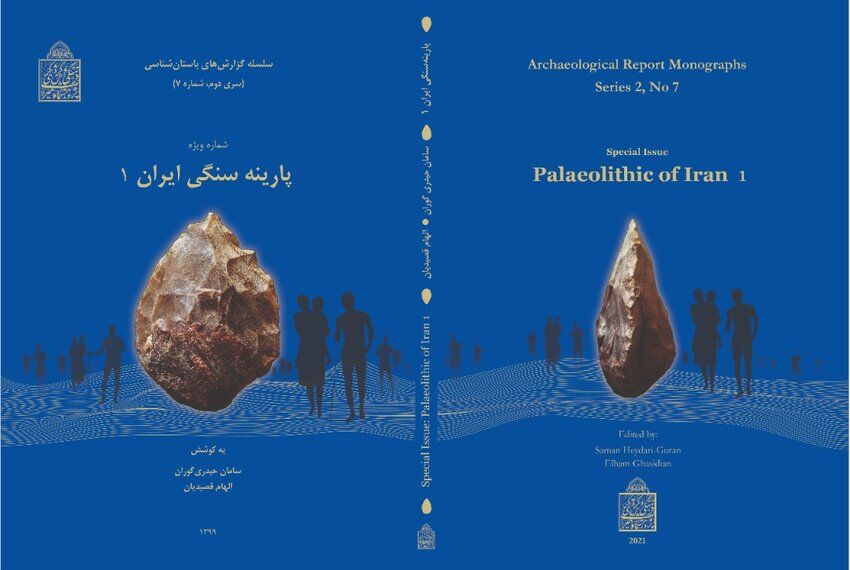 | Heydari-Guran, Saman; Ghasidian, Elham: Special Issue: Paleolithic of Iran 1. In: Archaeological Report Monographs Series, iss. 2, no. 7, 2021. @article{nokey,
title = {Special Issue: Paleolithic of Iran 1},
author = {Saman Heydari-Guran and Elham Ghasidian},
editor = {Saman Heydari-Guran and Elham Ghasidian},
year = {2021},
date = {2021-00-00},
urldate = {2021-00-00},
journal = {Archaeological Report Monographs Series},
number = {7},
issue = {2},
keywords = {Palaeolithic},
pubstate = {published},
tppubtype = {article}
}
|
| Hoffmann, Birgitt: The WaqfnāMa-Yi Rabʿ-I RashīDī – The Most Important Written Source for the Understanding of the Rabʿ-I RashīDī Endowment. In: Proceedings of the First International Conference on the Commemoration of Rashid al-Din Fazl-Allah Hamadani (University of Tabriz, March 2021), pp. 337-348, University of Tabriz Press, Tabriz, 2021. @inbook{nokey,
title = {The WaqfnāMa-Yi Rabʿ-I RashīDī – The Most Important Written Source for the Understanding of the Rabʿ-I RashīDī Endowment},
author = {Birgitt Hoffmann},
year = {2021},
date = {2021-00-00},
urldate = {2021-00-00},
booktitle = {Proceedings of the First International Conference on the Commemoration of Rashid al-Din Fazl-Allah Hamadani (University of Tabriz, March 2021)},
pages = {337-348},
publisher = {University of Tabriz Press},
address = {Tabriz},
keywords = {Administration, Foundation, Ilkhanate, Institutions, Mongols, Textual sources},
pubstate = {published},
tppubtype = {inbook}
}
|
| Fuchs, Christian: A Study of the Defensive Architecture on the Site. In: Proceedings of the First International Conference on the Commemoration of Rashid al-Din Fazl-Allah Hamadani (University of Tabriz, March 2021), pp. 265-294, University of Tabriz Press, Tabriz, 2021. @inbook{nokey,
title = {A Study of the Defensive Architecture on the Site},
author = {Christian Fuchs},
year = {2021},
date = {2021-00-00},
urldate = {2021-00-00},
booktitle = {Proceedings of the First International Conference on the Commemoration of Rashid al-Din Fazl-Allah Hamadani (University of Tabriz, March 2021)},
pages = {265-294},
publisher = {University of Tabriz Press},
address = {Tabriz},
keywords = {Fortification},
pubstate = {published},
tppubtype = {inbook}
}
|
| Korn, Lorenz; Heidenreich, Anja: The Site of Rabʿ-i Rashidi, Tabriz: Goals and Beginnings of the Iranian-German Research Project. In: Proceedings of the First International Conference on the Commemoration of Rashid al-Din Fazl-Allah Hamadani (University of Tabriz, March 2021), pp. 295-314, University of Tabriz Press, 2021. @inbook{nokey,
title = {The Site of Rabʿ-i Rashidi, Tabriz: Goals and Beginnings of the Iranian-German Research Project},
author = {Lorenz Korn and Anja Heidenreich},
year = {2021},
date = {2021-00-00},
urldate = {2021-00-00},
booktitle = {Proceedings of the First International Conference on the Commemoration of Rashid al-Din Fazl-Allah Hamadani (University of Tabriz, March 2021)},
pages = {295-314},
publisher = {University of Tabriz Press},
keywords = {Administration, Architecture, Ilkhanate, Institutions, Mongols},
pubstate = {published},
tppubtype = {inbook}
}
|
| Maziar, Sepideh: Resilienz bei Pandemie; Kurzbericht zum Projekt ‘Resilience in the Diaspora‘. In: ENKI; Archäologie und Kunstgeschichte des Vorderen Orients, iss. 22, pp. 26-28, 2021. @article{nokey,
title = {Resilienz bei Pandemie; Kurzbericht zum Projekt ‘Resilience in the Diaspora‘},
author = {Sepideh Maziar},
year = {2021},
date = {2021-00-00},
urldate = {2021-00-00},
journal = {ENKI; Archäologie und Kunstgeschichte des Vorderen Orients},
issue = {22},
pages = {26-28},
keywords = {Resilience},
pubstate = {published},
tppubtype = {article}
}
|
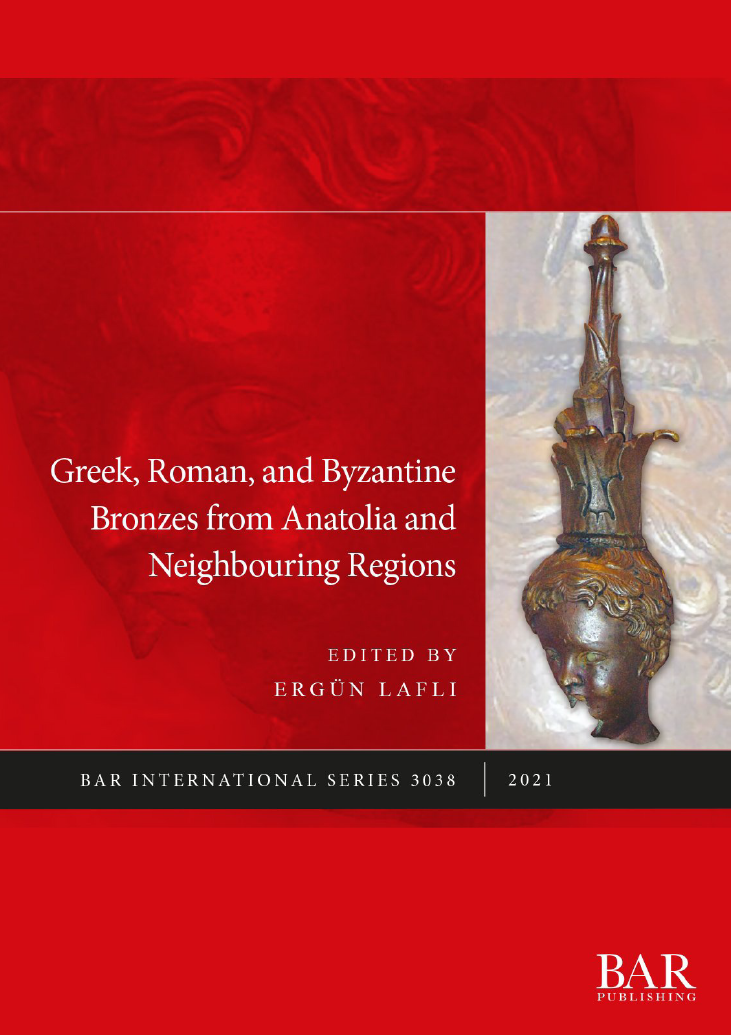 | Soltani, Anise Nejad; Maziar, Sepideh; Mortazavi, Mohammad: Scientific Investigation On a Copper-Based Pin from Köhn Pāsga Tepesi in the Province of Eastern Azerbaijan (Iran). In: Laflı, Ergün (Ed.): Greek, Roman, and Byzantine Bronzes from Anatolia and Neighbouring Regions, pp. 305-309, BAR Publishing, Oxford, 2021. @inbook{nokey,
title = {Scientific Investigation On a Copper-Based Pin from Köhn Pāsga Tepesi in the Province of Eastern Azerbaijan (Iran)},
author = {Anise Nejad Soltani and Sepideh Maziar and Mohammad Mortazavi},
editor = {Ergün Laflı},
url = {https://www.researchgate.net/publication/354403320_2021_Scientific_investigation_on_a_copper-based_pin_from_Kohne_Pasgah_Tepesi_in_the_province_of_Eastern_Azerbaijan_Iran},
year = {2021},
date = {2021-00-00},
urldate = {2021-00-00},
booktitle = {Greek, Roman, and Byzantine Bronzes from Anatolia and Neighbouring Regions},
pages = {305-309},
publisher = {BAR Publishing},
address = {Oxford},
series = {BAR international series 3038},
abstract = {In this paper a copper-based pin found in Köhné Pāsgāh Tepesi excavations has been investigated. This archaeological site is located between the villages of Máfrüzlü and Shoja'lu, and is part of the administrative district of Káleybár district, in East Azerbaijan province, Iran. It is located on the south bank of the Araxes valley in the Khodääfarin area. The site is one of several sites that will be submerged by the Khodääfarin dam project.The pin has been thoroughly examined in an attempt to find more about the elements used in the alloys' composition and the manufacturing methods of this object. The analytical methods used include ICP, SEM-EDX and metallography. According to the analytical data, an arsenic-copper alloy has been used to make this object with arsenic content about 3%. The metallographic studies showed banded microstructure evident chemical segregation, but also implied cold working used effectively to manufacture the pin.},
keywords = {Archaeometallurgy, Copper, copper base, East Azerbaijan},
pubstate = {published},
tppubtype = {inbook}
}
In this paper a copper-based pin found in Köhné Pāsgāh Tepesi excavations has been investigated. This archaeological site is located between the villages of Máfrüzlü and Shoja'lu, and is part of the administrative district of Káleybár district, in East Azerbaijan province, Iran. It is located on the south bank of the Araxes valley in the Khodääfarin area. The site is one of several sites that will be submerged by the Khodääfarin dam project.The pin has been thoroughly examined in an attempt to find more about the elements used in the alloys' composition and the manufacturing methods of this object. The analytical methods used include ICP, SEM-EDX and metallography. According to the analytical data, an arsenic-copper alloy has been used to make this object with arsenic content about 3%. The metallographic studies showed banded microstructure evident chemical segregation, but also implied cold working used effectively to manufacture the pin. |
 | Stöllner, Thomas; Aali, Abolfazl: Long-Term Salt Mining in Chehrābād: Resilient Strategies in Accessing Mineral Resources at the Iranian Highlands. In: Pearls, Politics and Pistachios: Essays in Anthropology and Memories on the Occasion of Susan Pollock’s 65th Birthday, pp. 352-369, Ex Oriente/Propylaeum, Berlin/Heidelberg, 2021. @inbook{nokey,
title = {Long-Term Salt Mining in Chehrābād: Resilient Strategies in Accessing Mineral Resources at the Iranian Highlands},
author = {Thomas Stöllner and Abolfazl Aali},
doi = {https://doi.org/10.11588/propylaeum.837},
year = {2021},
date = {2021-00-00},
urldate = {2021-00-00},
booktitle = {Pearls, Politics and Pistachios: Essays in Anthropology and Memories on the Occasion of Susan Pollock’s 65th Birthday},
pages = {352-369},
publisher = {Ex Oriente/Propylaeum},
address = {Berlin/Heidelberg},
keywords = {Achaemenid, Administration, Bronze Age, Chalcolithic, Institutions, Iron Age, Islamic era, Minerals, Mining, Neolithic, Resilience, Resources, Salt, Sasanian, Zanjan},
pubstate = {published},
tppubtype = {inbook}
}
|
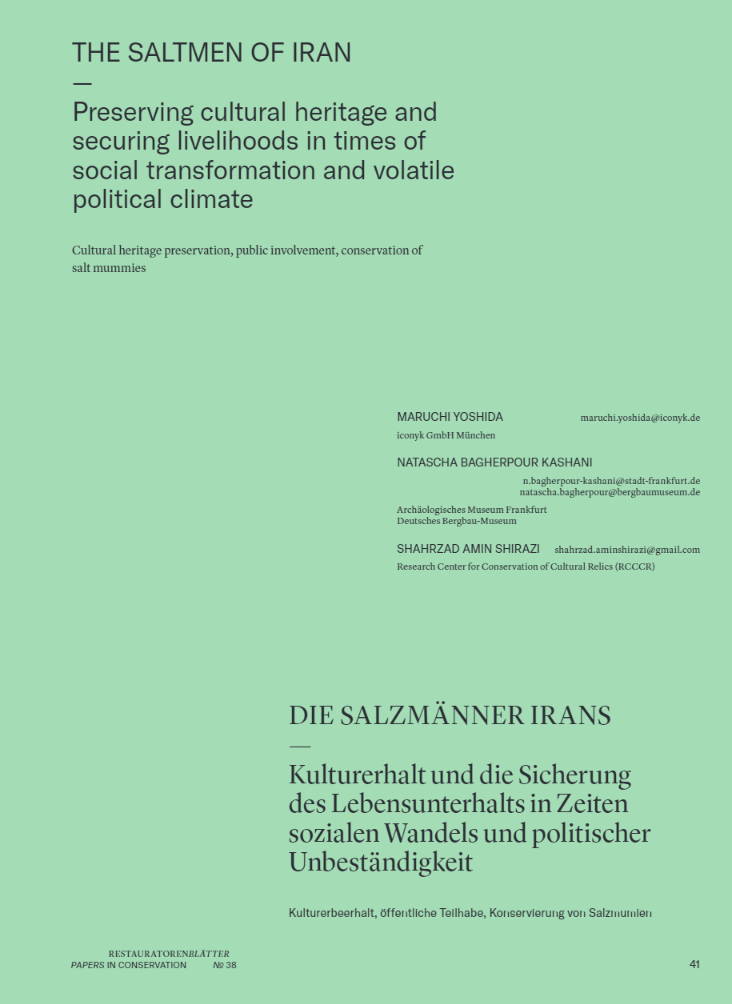 | Kashani, Natascha Bagherpour; Shirazi, Shahrzad Amin; Yoshida, Maruchi: The Saltmen of Iran – Preserving Cultural Heritage and Securing Livelihoods in Times of Social Transformation and Volatile Political Climate. In: Papers in Conservation , vol. 38, pp. 41-58, 2021. @article{nokey,
title = {The Saltmen of Iran – Preserving Cultural Heritage and Securing Livelihoods in Times of Social Transformation and Volatile Political Climate},
author = {Natascha Bagherpour Kashani and Shahrzad Amin Shirazi and Maruchi Yoshida},
url = {https://www.researchgate.net/publication/363627491_THE_SALTMEN_OF_IRAN_Preserving_cultural_heritage_and_securing_livelihoods_in_times_of_social_transformation_and_volatile_political_climate},
year = {2021},
date = {2021-00-00},
journal = {Papers in Conservation },
volume = {38},
pages = {41-58},
publisher = {Publications of the International Institute for Conservation of Historic and Artistic Works (IIC)},
abstract = {After an initial chance find in 1993, research excavations in the ancient salt mine of Chehrābād (Zanjan Province, Iran) unearthed several salt mummies and organic finds of textile and leather, as well as tools and ceramic vessels. The finds predominantly date to the Achaemenid (550–330 BCE) and Sassanid periods (224–642 CE). The organic substances preserved by the salt contain valuable information that contributes to the understanding of the living environment of these periods and to the reconstruction of social structures of past societies. The salt mine in Chehrābād and the finds displayed in the museum of the provincial capital Zanjan are an important cultural heritage whose preservation is understood as a joint task of the local population, the province and the central cultural authority. The Iranian-German projects dealing with the salt mummies of Iran are concerned, on the one hand, with developing sustainable conservation concepts for the salt mine and the collection in the museum that are adapted to local conditions. On the other hand, incentives are created for the local population to participate in the preservation of the cultural heritage.},
keywords = {Salt},
pubstate = {published},
tppubtype = {article}
}
After an initial chance find in 1993, research excavations in the ancient salt mine of Chehrābād (Zanjan Province, Iran) unearthed several salt mummies and organic finds of textile and leather, as well as tools and ceramic vessels. The finds predominantly date to the Achaemenid (550–330 BCE) and Sassanid periods (224–642 CE). The organic substances preserved by the salt contain valuable information that contributes to the understanding of the living environment of these periods and to the reconstruction of social structures of past societies. The salt mine in Chehrābād and the finds displayed in the museum of the provincial capital Zanjan are an important cultural heritage whose preservation is understood as a joint task of the local population, the province and the central cultural authority. The Iranian-German projects dealing with the salt mummies of Iran are concerned, on the one hand, with developing sustainable conservation concepts for the salt mine and the collection in the museum that are adapted to local conditions. On the other hand, incentives are created for the local population to participate in the preservation of the cultural heritage. |
 | Kashani, Natascha Bagherpour; Yoshida, Maruchi; Stöllner, Thomas: Die Salzmänner von Iran. Kulturerhalt als Treiber und Ermöglicher einer nachhaltigen Entwicklung. In: Museumskunde, Fachzeitschrift für die Museumswelt, vol. 1, pp. 34-42, 2021. @article{nokey,
title = {Die Salzmänner von Iran. Kulturerhalt als Treiber und Ermöglicher einer nachhaltigen Entwicklung},
author = {Natascha Bagherpour Kashani and Maruchi Yoshida and Thomas Stöllner},
url = {https://www.researchgate.net/publication/363628987_Die_Salzmanner_von_Iran_Kulturerhalt_als_Treiber_und_Ermoglicher_einer_nachhaltigen_Entwicklung},
year = {2021},
date = {2021-00-00},
journal = {Museumskunde, Fachzeitschrift für die Museumswelt},
volume = {1},
pages = {34-42},
publisher = {Deutscher Museumsbund},
abstract = {Museumsarbeit und Kulturerbeerhalt können zur Erreichung der in der Agenda 2030 festgeschriebenen Ziele für nachhaltige Entwicklung beitragen. Die Herausforderung, Museen ökologisch und sozial zu gestalten oder Museen als kulturelle und nachhaltige Bildungsorte zu etablieren, ist in Ländern, wie in unserem Beispiel Iran, umso größer, je mehr eine Gesellschaft unter sozialen Spannungen und wirtschaftlichen Sanktionen zu leiden hat. Mit den laufenden Projekten verfolgt das Autor*innen-Team das Ziel, die Partnermuseen und deren Trägerbehörden in Iran dabei zu unterstützen, einen wirksamen Beitrag zur menschlichen und sozioökonomischen Entwicklung, zu hochwertiger Bildung und sozialer Inklusion, zur ökologischen Nachhaltigkeit und zu friedlichen Gesellschaften zu leisten.
},
keywords = {Salt},
pubstate = {published},
tppubtype = {article}
}
Museumsarbeit und Kulturerbeerhalt können zur Erreichung der in der Agenda 2030 festgeschriebenen Ziele für nachhaltige Entwicklung beitragen. Die Herausforderung, Museen ökologisch und sozial zu gestalten oder Museen als kulturelle und nachhaltige Bildungsorte zu etablieren, ist in Ländern, wie in unserem Beispiel Iran, umso größer, je mehr eine Gesellschaft unter sozialen Spannungen und wirtschaftlichen Sanktionen zu leiden hat. Mit den laufenden Projekten verfolgt das Autor*innen-Team das Ziel, die Partnermuseen und deren Trägerbehörden in Iran dabei zu unterstützen, einen wirksamen Beitrag zur menschlichen und sozioökonomischen Entwicklung, zu hochwertiger Bildung und sozialer Inklusion, zur ökologischen Nachhaltigkeit und zu friedlichen Gesellschaften zu leisten.
|
2020
|
 | Stöllner, Thomas; Aali, Abolfazl; Kashani, Natascha Bagherpour (Ed.): Tod im Salz. Eine archäologische Ermittlung in Persien. Nünnerich-Asmus Verlag & Media GmbH, 2020, ISBN: 978-3-96176-141-8. @book{nokey,
title = {Tod im Salz. Eine archäologische Ermittlung in Persien},
editor = {Thomas Stöllner and Abolfazl Aali and Natascha Bagherpour Kashani},
url = {https://bergbaumuseum-shop.de/Tod-im-Salz-Eine-archaeologische-Ermittlung-in-Persien-Begleitbuch-Katalog-und-Graphic-Novel},
isbn = {978-3-96176-141-8},
year = {2020},
date = {2020-12-16},
urldate = {2020-12-16},
publisher = {Nünnerich-Asmus Verlag & Media GmbH},
abstract = {Since the first discoveries in 1993 bodies or body-parts of eight humans have been discovered at the salt-mine of Douzlākh at Chehrābād. These bodies allow a reconstruction of their lives as workers during the different operation periods. By involving many different scientific fields, it became possible to investigate their palaeo-medical aspects, their diet and their health status as well the causes of their
death and their involvement into different aspects of the mining operation and logistics of the mine. It is possible not only to reconstruct three different catastrophes during the Achaemenid, the early and the late Sasanian times but also to understand the social aspects of the working people. The Achaemenid miners certainly came from abroad but already stayed a while in the region, apart from the young miner no. 4 who seems to have arrived shortly before the catastrophe. This group of migrants possibly were sent within a “bandaka”, an Achaemenid labour duty. The Sassanian miners partly came from a “regional” background but also came shortly before their deaths. Saltman 1 is interesting as he is an older individual who possibly had a special role within the miners. Mining at Douzlakh was predominantly operated in periods of strong centralized political systems when governmental activities could be organized over longer distances.},
keywords = {Achaemenid, Administration, Bronze Age, Chalcolithic, Institutions, Iron Age, Islamic era, Minerals, Mining, Mobility, Neolithic, Salt, Sasanian, Zanjan},
pubstate = {published},
tppubtype = {book}
}
Since the first discoveries in 1993 bodies or body-parts of eight humans have been discovered at the salt-mine of Douzlākh at Chehrābād. These bodies allow a reconstruction of their lives as workers during the different operation periods. By involving many different scientific fields, it became possible to investigate their palaeo-medical aspects, their diet and their health status as well the causes of their
death and their involvement into different aspects of the mining operation and logistics of the mine. It is possible not only to reconstruct three different catastrophes during the Achaemenid, the early and the late Sasanian times but also to understand the social aspects of the working people. The Achaemenid miners certainly came from abroad but already stayed a while in the region, apart from the young miner no. 4 who seems to have arrived shortly before the catastrophe. This group of migrants possibly were sent within a “bandaka”, an Achaemenid labour duty. The Sassanian miners partly came from a “regional” background but also came shortly before their deaths. Saltman 1 is interesting as he is an older individual who possibly had a special role within the miners. Mining at Douzlakh was predominantly operated in periods of strong centralized political systems when governmental activities could be organized over longer distances. |













































